WBBSE Chapter 7 Movements Organized By Women, Students, And Marginal People In 20th Century India: Characteristics And Analyses Very Short Answer Questions
Question 1. Which day was declared as International Women’s Day?
Answer: 4th March 1975.
Question 2. Which class of women were more active during the Anti-partition of Bengal Movement?
Answer: The women of higher caste and educated or western-educated women.
Read and learn all WBBSE Solutions For Class 10 History And Environment
Question 3. Who formed the ‘Bhagini Sena’ or army of sisters?
Answer: Matangini Hazra.
Question 4. Which institutions were opened at the initiative of Deepali Sangha?
Answer: A girls’ High School, an Adult Education Centre, and 15 primary schools.
Question 5. What was the women’s brigade in ‘Azad Hind Fauj’ known as?
Answer: Jhansi Brigade.
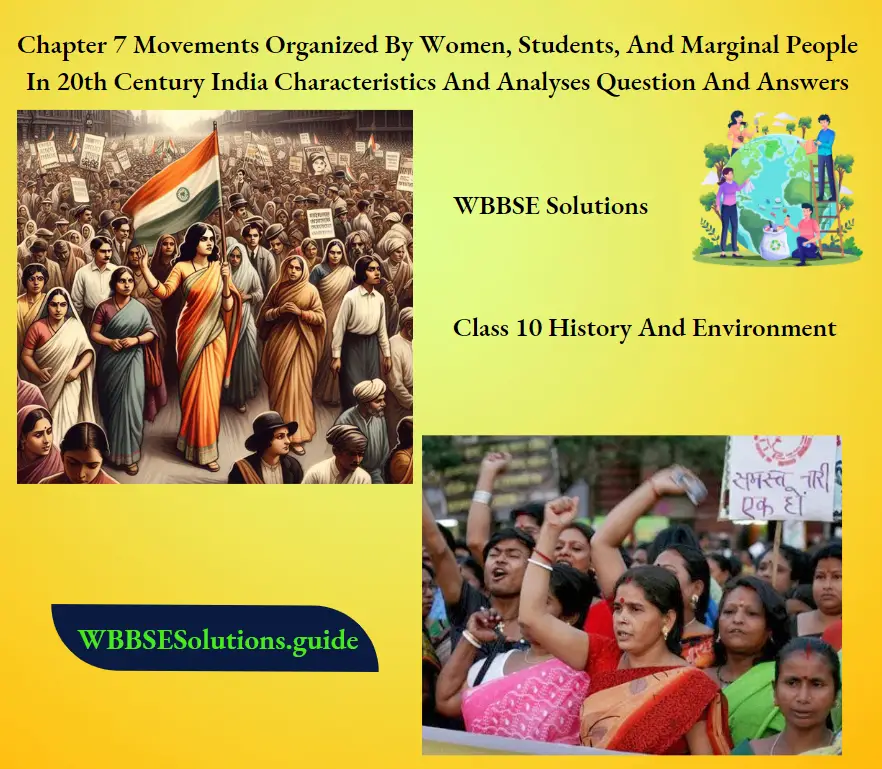
Question 6. When did the students’ movement begin in India?
Answer: In the second half of the nineteenth century.
Question 7. What was the reason for the students’ strike all over the country on 6th April 1919?
Answer: Protest against the Rowlatt Act.
“WBBSE Class 10 History Chapter 7 solutions, Movements by Women, Students, and Marginal People”
Question 8. What was the character of the student movement in the post-World War II period?
Answer: The anti-Fascism nature of the students’ movement became popular.
Question 9. What was the main achievement of Surya Sen?
Answer: The Chittagong Armoury Raid was the main achievement of Surya Sen.
Question 10. Who is called the Margaret Thatcher of India?
Answer: Mrs. Indira Gandhi.
Question 11. When was International Women’s Day observed for the first time?
Answer: 8th March 1975.
Question 12. Which period is called the ‘Women’s Decade’?
Answer: 1975-854.
Question 13. Who Founded the “Sebasadan”?
Answer: Ramabai Ranade.
Question 14. Name one woman who participated in the Non-Cooperation Movement.
Answer: Renuka Roy.
Question 15. Who started the ‘Beerashtami Brata’?
Answer: Sarala Devi.
Question 16. Who is known as the ‘Cuckoo of India’?
Answer: Sarojini Naidu.
Question 17. Who is also known as the ‘Nightingale of India’?
Answer: Sarojini Naidu.
Question 18. Who formed Sakhi Samity?
Answer: Swarma Debi.
Question 19. Who formed ‘Lakhmir Bhandar’?
Answer: Sarala Devi Chowdhurani.
Question 20. Name the publisher of the magazine ‘Suprabhat.’
Answer: Kumudini Mitra.
Question 21. Name a book written by Sarojini Naidu.
Answer: The Golden Threshold (1905).
Question 22. Name the first woman President of the Indian National Congress.
Answer: Sarojini Naidu.
Question 23. Who formed Mahila Parishad (1905)?
Answer: Ramabai Ranade.
Question 24. Who founded Nari Karma Mandir?
Answer: Urmila Devi.
Question 25. Who formed Bhagini Sena?
Answer: Matangini Hazra.
Question 26. Name the 73-year-old woman who participated in the Quit India Movement.
Answer: Matangini Hazra.
Question 27. Name a revolutionary woman of Anushilan Samity.
Answer: Nivedita.
Question 28. Who is known as the mother of Indian revolutionary ideas?
Answer: Mrs. Vikaji Rustamji Kama.
Question 29. Who formed Azad Hind Fauj?
Answer: Subhash Chandra Bose.
Question 30. Who was named as ‘Captain Lakshmi’?
Answer: Lakshmi Sehgal.
Question 31. Which lady was convicted in the ‘Titagarh Conspiracy Case’?
Answer: Parul Mukherjee.
Question 32. Who established Deepali Sangha?
Answer: Leeia Nag (Roy).
Question 33. When was Deepali Chhatri Sangha founded?
Answer: 1926.
Question 34. Name the first female students’ organization in India.
Answer: Deepali Chhatri Sangha.
Question 35. Name a magazine edited by Leela Roy.
Answer: Jayashri (1931).
Question 36. Name the first revolutionary woman of India to become a martyr.
Answer: Pritilata Waddedar.
Question 37. Who was called by Tagore as ‘Agnikanya’?
Answer: Kalpana Dutta.
Question 38. Name the woman involved in the Dynamite Conspiracy Case.
Answer: Kalpana Dutta.
Question 39. Which woman committed suicide by eating potassium cyanide?
Answer: Pritilata Waddedar.
Question 40. Who was hanged after the end of the trial of the Lahore Conspiracy Case?
Answer: Bhagat Singh.
Question 41. Who was the first student martyr from Punjab?
Answer: Khusiram.
Question 42. Under whose leadership was the All Bengal Students’ Association (ABSA) formed?
Answer: Jyotindra Mohan Sengupta.
Question 43. Under whose leadership was the Bengal Presidency Students’ Association formed?
Answer: Subhash Chandra Bose.
Question 44. Name the students’ organization formed by Biswanath Mukhopadhyay.
Answer: Bengal Students’ League.
Question 45. Who called the students in a Rakshabandhan Ceremony to join the boycott movement?
Answer: Rabindranath Tagore.
Question 46. Who was known as Deshapran?
Answer: Birendranath Sashmal.
Question 47. Who formed the Anti-Circular Society?
Answer: Sachindra Prasad Basu.
Question 48. When was the Anti-Circular Society formed?
Answer: On 4th November 1905.
Question 49. Which circular forbade the slogan of Vande Mataram?
Answer: Carlyle Circular.
Question 50. Who formed ‘Bengal Volunteers’?
Answer: Hemchandra Ghosh.
Question 51. Name the autobiography of Bina Das.
Answer: Srinkhal Jhankar.
Question 52. Name a member of Chhatri Sangha.
Answer: Bina Das.
Question 53. Who formed ‘Satya Shodhak Samaj’ (1873)?
Answer: Mahatma Jyotiba Phule.
Question 54. Who founded the Dalit Mission Society?
Answer: V.R. Shilde.
Question 55. Who announced the Communal Award?
Answer: Sir Ramsay Mcdonald.
Question 56. Name the publisher of Harijan Patrika.
Answer: Mahatma Gandhi
Question 57. Who started Harijan Movement?
Answer: Mahatma Gandhi.
Question 58. Name the editor of ‘The Pataka’.
Answer: Raicharan Biswas.
Question 59. Who founded Matka Maha Sangha.
Answer: Promoth Ranjan Thakur.
Question 60. When was the Women’s Federation of India formed?
Answer: 1954.
Question 61. Who initiated the Quit India Movement?
Answer: Mahatma Gandhi started the Quit India Movement.
Question 62. Quit India Movement started in which year?
Answer: Quit India Movement started on 9th August 1942 A.D.
Question 63. Who appealed “Do or Die”?
Answer: Gandhiji appealed “Do or Die.”
Question 64. The report of Quit India was first published in which paper?
Answer: The report of Quit India was first published in Harijan Patrika.
Question 65. Who was called Gandhiburi during the time of the Quit India Movement?
Answer: Matangini Hazra of Midnapore was called Gandhiburi.
Question 66. Who gave leadership to the Quit India Movement after Gandhiji was arrested?
Answer: Abbas Tayebhji gave leadership to the Quit India Movement first and then Sarojini Naidu after the arrest of Gandhiji.
Question 67. Who gave leadership to the Jhansi Brigade?
Answer: C.nt. Laxmi Swaminathan gave leadership to the Jhansi Brigade.
Question 68. Write the name of one woman leader who participated in the Chittagong Armoury Raid.
Answer: Kalpana Dutta.
Question 69. Which day was observed as “Rashid Ali Day”?
Answer: 13th June.
Question 70. Name a woman leader of the Civil Disobedience Movement.
Answer: Sarojini Naidu.
Question 71. In which year was Chittagong Armoury raided by Surya Sen?
Answer: In 1930.
Question 72. Name the woman revolutionary who attempted the life of the Bengal Governor Stanley Jackson.
Answer: Bina Das.
Question 73. What was the full name of ‘B.V’.?
Answer: Bengal Volunteers.
Question 74. Name one revolutionary of the ‘corridor warfare.’
Answer: Binoy Bose.
Question 75. What was the real name of Masterda?
Answer: Surya Sen.
Question 76. When did the student community of Calcutta start a movement for the release of Captain Rashid Ali?
Answer: In 1946.
Question 77. What were the features of the students’ movement before 1919?
Answer: Students’ movement during this period were marked by two important features, viz. their extreme enthusiasm about boycotting British goods, enhanced anti-British feeling all around, and the young student community was greatly influenced by revolutionary movements, the Russian Revolution and equality and socialist ideals.
Question 78. What was ‘Bengal Volunteers’?
Answer: Bengal Volunteers or B.V. was a social welfare organization, with its head office in Dhaka, set up by Hemchandra Ghosh. He was inspired by Swami Vivekananda, Aurobindo Ghosh, and Brahmabandhab Upadhyay. The B.V. party also participated in many covert revolutionary activities. Later, all the members joined the Forward Bloc party of Subhas Chandra Bose.
Question 79. How did the students participate in the Quit India Movement?
Answer: The students joined the movement without caring about the government’s threat of arrests or paying any heed to any restrictions. Students’ movement took a violent form throughout India. Since the Students Federation run by Congress was banned, it was led by the Communist Party, Forward Bloc, and RSP. They actively participated in various social service and relief activities. Student movement spread like a huge wave from Kashmir to Kanyakumari during this time.
Question 80. Name two military women of the Tebhaga Movement.
Answer: Ila Mitra, Rina Guha, and others were fire-brand leaders of the Tebhaga Movement (1948-49).
Question 81. Name two student leaders of the Non-Cooperation Movement.
Answer: Two student leaders of the on-Cooperation Movement were Birendranath Sashmal and Biren Dasgupta.
Question 82. Name two revolutionaries of Bengal Volunteers.
Answer: Two revolutionaries of Bengal Volunteers were Hemchandra Ghosh and Leela Nag (Roy).
Question 83. How did the womenfolk of Bengal observe the day of the Partition of Bengal on 16 October 1905?
Answer: The day of partition (16 October 1905) was observed by the women throughout Bengal as the day of protest. About five hundred women gathered on the day of partition in North Calcutta to watch the foundation of the Federation Hall, which was a symbol of unity of the Bengali people.
Question 84. Narrate the incident that immortalized Midnapur of West Bengal during the Quit India Movement.
Answer: The incident that immortalized Midnapur in the history of the freedom movement was the lead given by Srimati Matangini Hazra, a 73-year-old widow, in capturing the court and the police station of Tamluk.
Question 85. Mention the daring feat of revolutionary Pritilata Waddedar of Chittagong.
Answer: On 24 September, Pritilata led seven young boy-revolutionaries to make a daring attack upon the Europeans at the Assam-Bengal Railway European Club in Chittagong hills.
Question 86. Mention two of the causes of the failure of the Quit India movement.
Answer:
1. unarmed people without leaders and proper organization fought against the British police and military firings.
2. The movement was not supported by all political parties.
Question 87. Who was Rashid Ali? Why was there mass agitation for him?
Answer: Rashid Ali had been a Captain of INA. He was given a life term by the court martial. So, there was mass agitation in Calcutta against the verdict.
“West Bengal Board Class 10 History Chapter 7, solved questions and answers”
Question 88. What is known as “Corridor War”?
Answer: There were three revolutionaries of Bengal volunteers. The trio made a daring attempt to raid the heart of the British rule, the Writers Building, and thus involved themselves in what is known as corridor warfare. In this venture,e they had to clash with the police, and at last, to evade arrest, Badal killed himself, Benoy die,d and Dinesh was hanged to death.
Question 89. Mention any two ways in which the Quit India Movement was different from earlier mass movements.
Answer: On August 8, 1942 the Congress adopted the historic “Quit India Resolution’ which declar,,ed among other the,ings that the immediate ending of the British rule in India was an urgent necessity. It was further resolved that the Congress was to launch a movement on the lines suggested by Gandhiji. It may be noted here that Gandhiji was now in a militant mood and was in favor of a mass struggle on the widest possible scale. In a historic speech, Gandhiji raised the slogan ‘Do or die.’
Question 90. What was the reaction in the country centering on the trial of Captain Rashid Ali?
Answer: Captain Rashid Ali of Azad Hind Fauj was imprisoned for 7 years. Students of Calcutta strongly protested for the release of Rashid Ali. Political leaders also joined in this movement. Rashid Ali Day was observed on 12 February 1946. Police resorted to firing. Armed forces were also asked to control the movement, which resulted in the death of 86 people, and 300 were injured.
Question 91. With which movement is the name of Matangini Hazra associated? Where did she give proof of her bravery?
Answer: The name of Matangini Hazra is associated with the Quit India Movement of 1942. A rare instance of bravery was shown by Matangini Hazra, a peasant widow of 72 years. She led a massive crowd marching towards the Tamluk thana (in Purba Medinipore) to hoist a flag.
Question 92. Who and when killed Governor Jackson?
Answer: Governor Jackson was killed by Bina Das in February 1932.
Question 93. Who and where founded Swadesh Bandhav Samiti?
Answer: Swadesh Bandhav Samiti was formed by Ashwini Kumar Dutta in Barisal.
Question 94. By which Act women got the right to vote in politics?
Answer: Due to the Montague-Chemsford Reforms Act of 1919,, women got the right to vote in politics.
Question 95. When and why was the All India Women Conference established?
Answer: All Indian Women Conference was established in 1927 to provide freedom to women in social & political spheres.
Question 96. Mention the name of the foreign women who participated in the Swadeshi and Boycott movement.
Answer: Mrs. Annie Besant participated in the Boycott and Swadeshi movement.
Question 97. When and why did women celebrate Rakhi Diwas?
Answer: Influenced by Rabindranath Tagore and as a protest against the partition of Bengal, women folk started celebrating Rakhi Diwas in 1905.
Question 98. In which states there was a protest against the partition of Bengal?
Answer: Delhi, Mumbai, Uttar Pradesh, and Bihar were the places where there was protest against the partition of Bengal.
Question 99. Name the women who participated ithe n the Non-Cooperation Movement.
Answer: Vijay Lakshmi Pandit, Basanti Devi, Suniti Devi, and Kasturba Gandhi were the main leaders who participated in the Non-Cooperation Movement.
Question 100. Who and why formed Nari Karma Mandir?
Answer: Nari Karma Mandir was formed by Urmila Devi to promote the use of ‘Charkha.’
Question 101. Name two female members of the Satyagraha Committee.
Answer: The Satyagraha Committee consisted of two female members, namely :
1. Urmila Devi
2. Hemprabha Das.
Question 102. What was the role of Sarojini Naidu inthe the Civil Disobedience Movement?
Answer: The women who participated in the Civil Disobedience Movement were Kurshid Behen, Mridula Saralabhai, Sarojini Naidu, and Aruna Asaf Ali.
Question 103. When did the Quit India Movement start?
Answer: Quit India movement was started on 9th August 1942.
Question 104. Who is known as Old Gandhi?
Answer: Matangini Hazra.
Question 105. Name the women who participated in the Quit India Movement.
Answer: The women who participated in the Quit India Movement are Matangini Hazra, Veena Das, Shashibala, Pratima Devi, and Ujjwala Mazumdar.
Question 106. Who and when edited the magazine Bande Mataram?
Answer: Bande Mataram magazine was edited by Madam Cama in 1909.
Question 107. Who and when founded Dipali Sangha?
Answer: Depali Sangha was formed by Leela Roy in 1924.
Question 108. What was the publication of Dipali Sangha?
Answer: Jaishree Patrika was published by Leela Roy in 1930.
Question 109. Mention the names of some leading female revolutionaries of Bengal.
Answer: The leading female revolutionaries of Bengal were Pritilata Waddedar, Veena Pani Roy, Kalpana Dutta, etc.
Question 110. When and under whose leadership was the Jhansi Brigade formed?
Answer:Thef Jhansi Brigade was formed under the leadership of Lakshmi Swaminathan in 1943.
Question 111. When and where wathe s the Swadeshi Movement declared?
Answer: Swadeshi movement was declared on 7th August 1905 in Town Hall, Kolkata.
Question 112. Who and when killed the Commissioner Rand of Poona?
Answer: Commissioner Rand of Poona was killed on 22nd June 1897 by Damodar Hari Chapekar and Balkrishna Hari Chapekar.
Question 113. Who and when formed Mitra Mela?
Answer: Nav Gopal Mitra formed Mitra Mela in 1899.
Question 114. Name two revolutionary families of Bengal.
Answer: Anushilan Samiti and Yugantar Dal were two revolutionary families of Bengal.
Question 115. Mention the namess of the organizations who voiced against casteism.
Answer: Brahma Samaj, Arya Samaj, Prarthana Samaj, Ramakrishna Mission, etc,. raised voices against casteism.
Question 116. Name two institutions set up by Ambedkar against casteism.
Answer: All India Depressed Class Association and The Depressed Class League were two associations formed by Ambedkar against casteism.
Question 117. When and by whose efforts Untouchabilityiity Act passed?
Answer: The Untouchability Act was passed in 1955 with the efforts of Bhim Rao Ambedkar.
Question 118. Who and when founded Bahiskrit Hitakarni Sabha?
Answer: Bhim Rao Ambedkar founded Bahiskrit Hitakarni Sabha in 1924.
Question 119. Who and when formed Anusuchit iati Parasangha?
Answer: B. R. Ambedkar formed Anusuchit Jati Parasangha in 1924.
Question 120. Who and when formed the Independent Labour Party?
Answer: Independence Labour Party was formed by B. R. Ambedkar in 1936.
Question 121. Who and when established Janjati Sangha?
Answer: B. R. Ambedkar established Janjati Sangha in 1942.
Question 122. Who was the President of the Drafting Committee of the Constituent Assembly?
Answer: B. R. Ambedkar was the President of the Drafting Committee of the Constituent Assembly.
Question 123. Who announced the Communal Award, and when?
Answer: Ramsay MacDonald announcedthe the Communal Award in 1932.
Question 124. Who and when published the magazine Harijan?
Answer: Harijan magazine was published by M.K. Gandhi in 1939.
Question 125. When and where did the Namashudra Movement start?
Answer: The Namashudra Movement was initially started in 1870 in the Ba’khergunj and Faridpur districts of West Bengal.
Question 126. Who formed Namassej Samaj?
Answer: Namassej Samaj was formed by the people of the Namasudra caste.
Question 127. What was the Carlyle Circular?
Answer: In 1905,, a circular, known as the Carlyle Circular, was issued that threatened to penalize those schools and colleges whose students would take part in the Swadeshi agitation.
Question 128. What was the reason behind the formation of the Anti-Circular Society (1905)?
AnswerToto encourage the students to participate in the Swadeshi movement, Sachindra Prasad Basu organized the Anti-Circular Society (1905). Besides encouraging the students, the Society made necessary arrangements for imparting education to those students who had been expelled by the government authorities under the Carlyle Circular.
Question 129. What were the contributions of Bina Das to the national freedom movement?
Answer: In her early days, Bina Das was one of the organizers of a student body at the political level. This was the Chhatri Sangha that started in Calcutta in 1928. Bina Das was instrumental in organizing the women students of different colleges of Calcutta for participation in the Satyagraha during the Civil Disobedience Movement. In 1932, Bina Das attempted the life of Stanley Jackson, the then Governor of Bengal. The attempt, however, misfired.
Question 130. State the principal characteristic of the women’s participation in the Anti-Partition of Bengal Movement.
Answer: The principal characteristic feature of the women’s movement during the Anti-Partition of Bengal Movement was that urban women of higher castes, the wealthy, and the bourgeois class were the main leaders of the movement. But they all aimed at promoting national interest.
Question 131. What was the Age of Freedom of Captive Women?
Answer: It is noted in history that men and women had fought together in armed revolutionary movements in India. If we analyze the characteristic features of the movement, it will be observed that women started showing interest in the armed revolution towards the last part of the nineteenth century. This era was called the ‘Age of Freedom of Captive Wome.’.
Chapter 7 Movements Organized By Women, Students, And Marginal People In 20th Century India: Characteristics And Analyses Short Answer Questions
Question 1. Why is Matangini Hazra so memorable?
Answer:
Matangini Hazra:
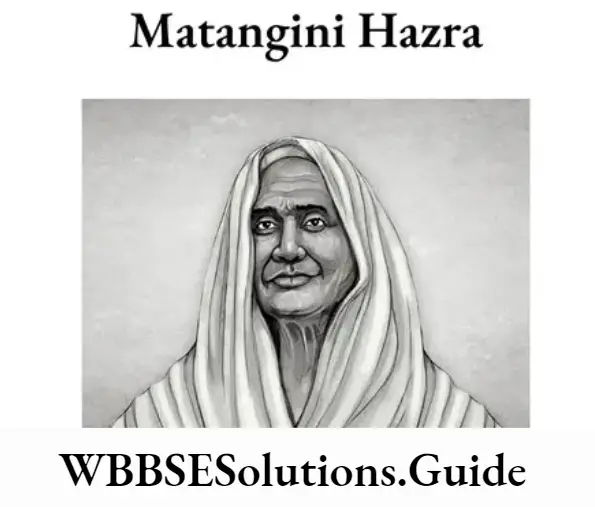
1. Introduction: The Quit India Movement took the shape of an intensified mass movement in Midnapore. On 29th September 1942 A.D, nearly 20,000 people made a procession to besiege the Government court and police station in Tamluk under the leadership of Matangini Hazra, a 73-year-old lady. She was holding the national flag in her hand and was singing the song ‘Vande Mataram.’
2. Police Action: Under her leadership, the movement in Tamluk took a sharp shape. Ultimately, police had to open fire to resist this procession. Matangini succumbed to a bullet injury in one hand, but she carried on the movement bravely to capture the Red House. At last, she fell to the ground, with a bullet shot in her chest.
But still, she was singing ‘Bandamatara..’ Her follower Ramchandra Bera was also self-sacrificed. Matangini’s death could not stop the movement and inspired thousands of Matanginis to carry on the movement. Many women of Mahishadal joined this Quit India Movement.
3. Formation of National Government: At this time, Shyamaprasad Mukherjee of Hindu Mahasabha resigned from the post of minister in protest of the torture made on the women. Being inspired by the sacrifice of Matangini Hazra, Ajay Mukherjee, Sushil Dhara, and Satish Samanta formed the Tamralipta National Government on 17th December 1942 A.D. The Army of this Government was known as Lightning Squad.
4. Gandhibur: The bravery and gallantry of Matangini Hazra are still very much fresh in the minds of the people of Tamluk, Patashpur Bhagabanpur, Mahishadal, Sutahata, Nandigram, etc. She became a prophet to the people of Midnapore and Bengal. So many people called her ‘Gandhiburi’ by comparing her achievements with Gandhi
“Class 10 WBBSE History Chapter 7 Q&A, Women, Students, and Marginal People Movements”
5. Conclusion: According to Nehru, nearly 10,000 people died in Midnapore during the Quit India Movement, as per official record, and nearly 60,000 people were arrested. Dr. Shyamaprasad Mukherjee wrote — “There was a deliberate challenge thrown out to the Governmen.”. Basically, due to Matangini Hazra, the Quit India Movement was so important.
Question 2. Why is Khudiram Bose so memorable in the freedom movement of India? Or, Why is Khudiram Bose so memorable?
Answer: Khudiram Bose (1889-1908 A.D.):
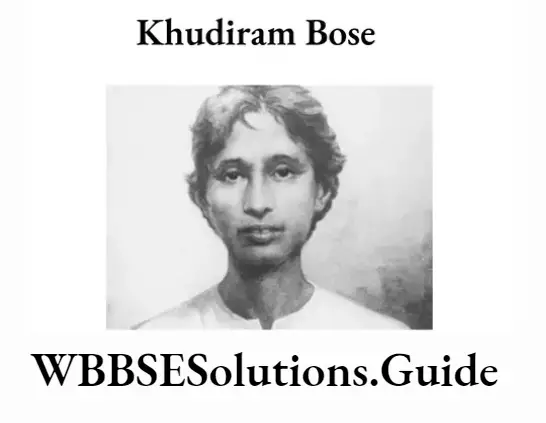
1. Introduction: Khudhiram Bose and Prafulla Chaki of the Yugantar group were appointed to assassinate Mr. Kingsford, the naughtorious Majistrate of Muzzafarpur,, but they wrongly killed Mrs. Kennedy and her daughter by a bomb in 1908. Khudiram was hanged to death in 19,08 and Prafulla Chaki committed suicide.
2. Yugantar Dal: During the days of the Bengal Partition movement, Khudiram distributed anti-British leaflets openly while it was strictly banned. After that, he joined Yugantar Dal. At this time, he was given the responsibility to murder the notorious District Magistrate Kingsford. This magistrate accused Aurobindo on the charge of sedition.
Under the instruction of Barindra Kumar Ghosh, Khudiram Bose and Prafulla Chaki took responsibility for murdering Kingsford. On 30th April 1908 A.D., Khudiram charged a powerful bomb to a horse cart ,,which they mistook as Kingsford’s. But unfortunately, that cart was carrying the innocent wife and daughter of Mr. Kenned,y and they died in the bomb explosion.
After this Muzaffarpur murder, Prafulla Chaki committed suicide out of fear of being arrested. Khudiram was arrested, tried, and hanged on 11th August 1908 A.D., at 6 a.m.
Question 3. Why is Surya Sen memorable?
Answer: Surya Sen (1893-1934 A.D.):
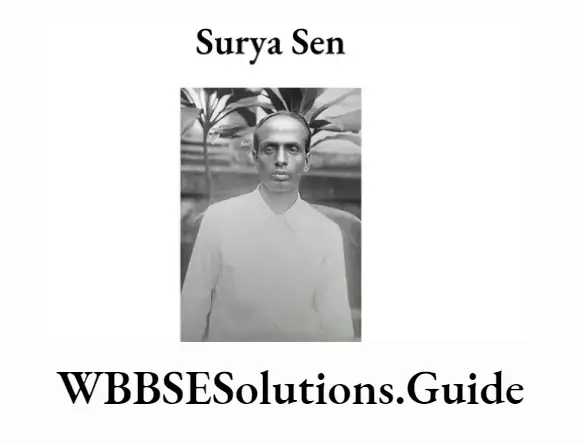
1. Introduction: Surya Kumar Sen (1893-1934 A.D.) was more known as ‘Master’ to the revolutionists. He was born in the Gairala Village of Chittagong in 1893 A.D. He passed B.A. from Baharampur College and was appointed as a teacher of Mathematics at Umatara High School. After that, he married Pushpalcuntala, a village woman.
But he could not lead a peaceful and happy domestic life because this 41-year-old teacher was all along engaged in revolutionary activities.
2. Indian Republican Army: The greatest event in the life of Surya Sen was the formation of the Indian Republican Army with 64 revolutionists on 1st April 1930 A.D. On 18th April 1930 A.D., they were divided into four teams and raided the Government Armoury in Chittagong, the Police Armoury, Telephone, and Telegraph Offices, and destroyed the rail lines.
They burnt the armory after looting. He procured one ‘Swiss gun’ from this armory. However, it could not be used due to the non-availability of ammunition. The main members of his team were Loknath Bal, Ambilka Chakravorty, Ganesh Ghosh, Ananta Singh, etc.
3. Chittagong Armoury Raid: After the raid of Chittagong Armoury, Surya Sen, along with his followers, took shelter in Jalalabad hills. After four days of being besieged, a violent battle took place between government soldiers and the soldiers of the Indian Republican Army. Many revolutionists died in this battle.
After that, they scattered around in different directions and started guerilla warfare. This is known as the ‘Jalalabad war of Independence Freedom Fight’
4. Result: 11 members of his team died in this battle. Harigopal Bal (Tegra), the youngest member of the team, died in this battle. He was only 13 years old. On the other side, 57 government soldiers died in that battle. The British soldiers had to retreat. In the meantime, they formed the ‘Provisional Independent Government of India’.
Kalpana Dutta and Pritilata Waddedar, the teammates of Surya Sen, murdered a high-ranking British officer while attacking one European club in Jalalabad. Pritilata was seriously wounded but committed suicide by taking potassium cyanide just to avoid arrest. After that, many members of the team died in the battle of Karnafuli.
While hiding in Gairala village, he was arrested by the police on 2nd February 1933 A.D. He was hanged on 12th January 1934 A.D. in Chittagong jail. This news was published in Panchajannya Patrika the next day. It is said that his dead body was not handed over to his relatives but was thrown away in the deep sea by carrying it in a ship.
After 10 years after the death of Surya Sen, Subhas Chandra Bose, as a descendent of Surya Sen, organized the last revolutionary insurgence in Bengal. Sir Samuel Hore said that the Chittagong Armoury raid wass a unique event in the history of revolution. Surya Sen, popularly known as ‘Master Da,’ made a plan of armed rebellion by looting the armory and sacrificing his life for the cause of the nation.
Question 4. Why is Bhagat Singh so memorable?
Answer:
Bhagat Singh (1907-1931):
Introduction: Shaheed-I-Azam Bhagat Singh is a glaring personality in the armed revolution of India. He was inspired by revolutionary ideology while studying at Lahore National College. His uncle, Ajit Singh, was a famous revolutionary.
Revolutionary Activities: Bhagat Singh came in contact with Chandra Sekhar Azad and took the membership of the Hindustan Republican Party in 1923. Later on, he and his fellow revolutionaries formed “Nawjawan Bharat Sabh,a” which was later renamed as “Hindustan Socialist Republican Association” with the socialistic ideology of the Russian Revolution.
- Bhagat Singh, Ashfaqullah, Dinanath, et,,c. were involved in the Kakori Conspiracy case.
- Bhagat Singh assassinated Mr. Sunders, the superintendent of police who was responsible for the death of Lala Lajpat Rai.
- Bhagat Singh and Batukeshwar Dutta threw bombs on the floor of the central legislative Assembly in 1929 while the discussion on the ‘Trade Dispute Bill’ and ‘Public Safety Bill’ was going on. These bills were against public interest.
Lahore Conspiracy Case: Thus he was arrested and hanged to death along with Sukhdev and Rajguru in 1931. Before stepping onto the hanging platform, Bhagat Singh shouted, “Inqulab Jindabad”. Bhagat Singh dreamt of a socialisd republic of India. According to Sita Ramayiyya, “Bhagat Singh’s name was widely known all over India and was as popular as Gandhiji.”
Question 5. Write a note on the Chittagong Armoury Raid.
Answer:
Chittagong Armoury Raid
Introduction: There was a revival of terrorism during the 30’s of the 20th century. The Chittagong group of revolutionaries, headed by Surya Sen, popularly known as Master Da, brought about a new birth of terrorism. Surya Sen formed the Indian Republican Army with his followers.
Followers: Among his followers, the names of Lokenath Bal, Ganesh Ghosh, Ananta Singh, and the two women Pritilata Waddedarand Kalpana Dutta must be mentioned.
Action plan:
Occupation of 2 main armories in Chittagong,
Destruction of the telephones and telegraph system in the city,
Armoury Raid: The revolutionaries raided the Chittagong Armoury on 18th April 1930 and looted the arms and ammunition stored there,e but they forgot to take the bullets. Hence,, their guns were of no use.
After the loot, they set it on fire and took shelter in the jungle of Jalalabad Hills. There was a severe battle between the revolutionaries and the British army. Surya Sen escaped,, but later on, he was arrested and sentenced to death.
Importance: Though the attempt didn’t succeed, the heroic fight of Surya Sen and his associates kindled the spirit of sacrifice among the young revolutionaries of India. The Chittagong incident enthused the entire nation and was a major boost for revolutionary activities.
Question 6. Why is Binoy-Badal-Dinesh remembered?
Answer:
Terrorist activities took up by Benoy, Badal, and Dinesh: Benoy Krishna Bose, Badal (alias Sudhir) Gupta, and Dinesh Gupta were the three distinguished members of the Bengal Volunteers and are more well known by the term “Benoy-Badal-Dine.”.” After committing a series of terrorist murders and bombings, these famous B.B.D were again engaged in killing Colonel Simpson, the inspector-general of the prison.
The famous Benoy- Badal-Dinesh, after taking responsibility for killing Colonel Simpson, entered the Writers’ Building on December 8, 1930, and finally shot Simpson. In history, this is known as the “Corridor warfare,” in which all three were cornered. Badal Gupta died immediately,y and Benoy Bose died a few days later.
Dinesh Gupta was brought to trial and was hanged to death by the order of the Court. Benoy, Badal, and Dinesh will remain immortal in the hearts and souls of all Indians for their heroic activities, unselfish deeds, and even more for their unparalleled love for their motherland. Binay Krishna Basu, Badal Gupta, and Dinesh Gupta, popularly known as B.B.D., gave a new impetus to the revolutionary movement in Bengal.
Corridor Warfare: Binay came to Calcutta and joined Bengal volunteers, a revolutionary group of Bengal. He me Badal Gupta and Dinesh Gupta. Binay, Badal, and Dinesh planned to attack the Writers’ Building in disguise dress on 8th December 1930 and shot dead Mr. Simpson, the inspector general of police.
The British police under Charles Tagert surrounded Writer’s Building, where a historic battle took place between the revolutionaries and British Police. This battle is known as Corridor warfare. Binay committed suicide, Badal swallowed poiso,,n and Dinesh was arrested and hanged to death. Thus, Binay, Badal, and Dinesh gave a new impetus to the revolutionary activities in Bengal.
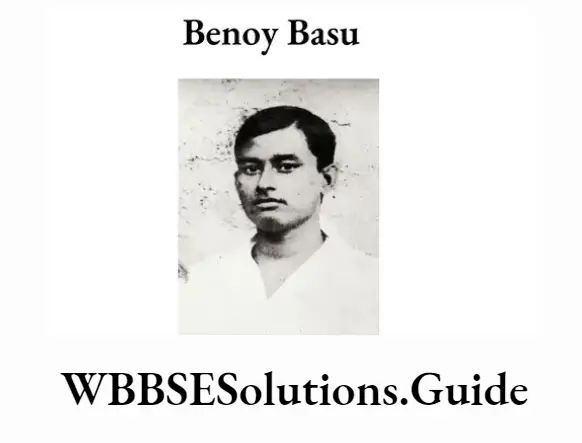
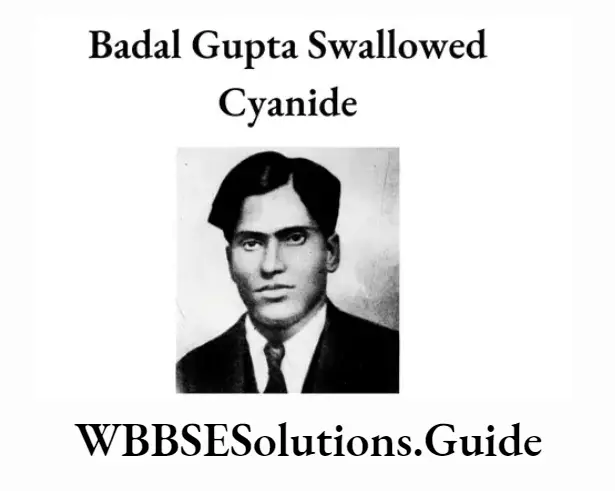
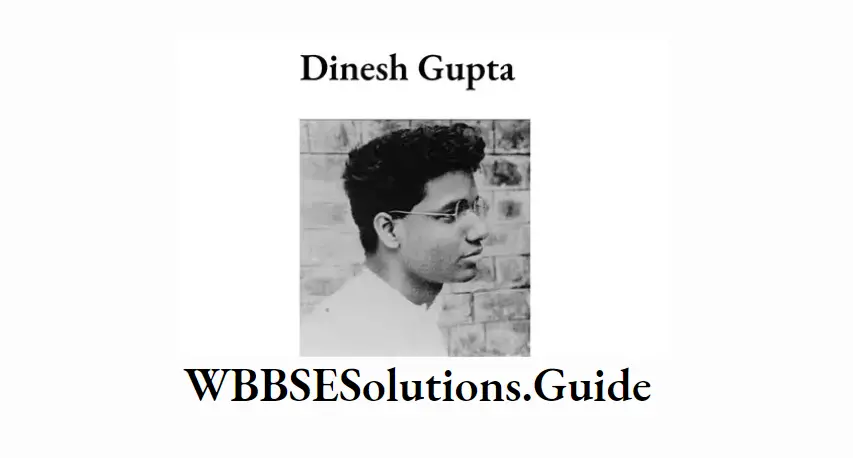
Question 7. What was the contribution of the student community to the Quit India Movement?
Answer:
Students Movement During Quit India Movement:
- Introduction: Quit India Movement started on 9th August 1942 and ended in 1944. During this time, Gandhiji gave his call, ‘If you want to remain unwavering in your struggle till independence is achieved, then shun schools and colleges and forget about studies for the time being and get ready for the ultimate fight.’
- Strikes and Processions: Students were very much at the forefront of the Quit India Movement. In the movement, the students of all schools and colleges of Bengal observed general strikes despite police atrocities on them. The Amrita Bazar Patrika reported that many students laid down their lives in the ’42 Movement.
- Militant Activities: However, despite Gandhiji’s non-violence, the Quit India Movement did not proceed along non-violent lines everywhere in the country. In Bengal, militancy had been growing among the common people, and the tendency was heightened under the influence of students’ activities.
- Students of Midnapur: In the city of Calcutta, the schools and colleges remained closed after 9 August 1942, the day the Quit India (or ’42) Movement began. However, the narrative of the student’s participation would never be complete without mentioning the militant action of the youths of Midnapur.
- The students of Tamluk, Contai (Kanthi), and Midnapur became restive. Young students like Pulin Sen, Birendranath Mai, Srimati Abha Maiti, and many others found Gandhiji’s call an opportunity for open rebellion. They began to spread the message of militant action and emerged as a leading political force.
Question 8. Write what you know about Kalpana Dutta.
Answer:
Kalpana Dutta:
Kalpana Datta (later Kalpana Joshi) was an Indian independence movement activist and a member of the armed independence movement led by Surya Sen, which carried out the Chittagong Armoury Raid in 1930. Late,r she joined the Communist Party of India and married Puran Chand Joshi, then General Secretary of the Communist Party of Ind,ia in 1943.
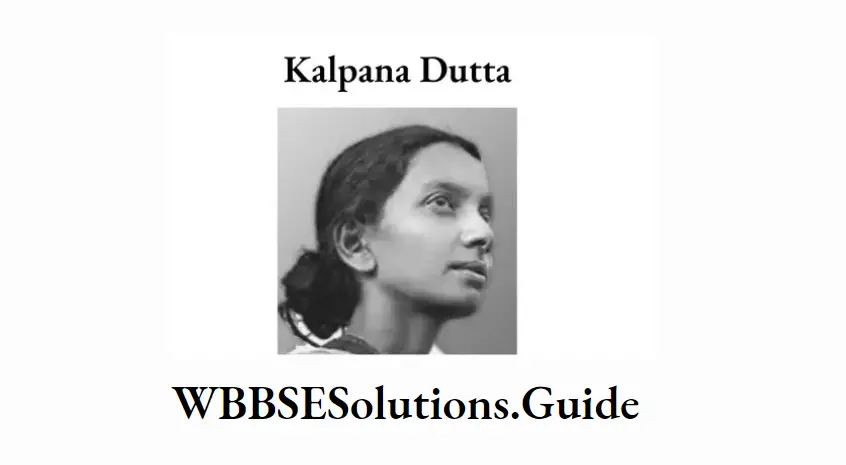
Armed Independence Movement: The Chittagong Armoury Raid was carried out on 18 April 1930. Kalpana joined the “Indian Republican Army, Chattagram bra,”h,” the armed resistance group led by Surya Sen in May 1931. In September 1931, Surya Sen entrusted he,r along with Pritilata Wadded,ar to attack the European Club in Chittagong.
But a week before the attack, she was arrested while carrying out a reconnaissance of the area. She went underground after her release on bail.
On 17 February 1933, the police encircled their hiding place, and Surya Sen was arrested, but Kalpana was able to escape. She was finally arrested on 19 May 1933. In the second supplementary trial of the Chittagong armory raid case, Kalpana was sentenced to imprisonment for life. She was released in 1939.
Question 9. Write what you know about Lakshmi Sehgal.
Answer:
Lakshmi Sehgal:
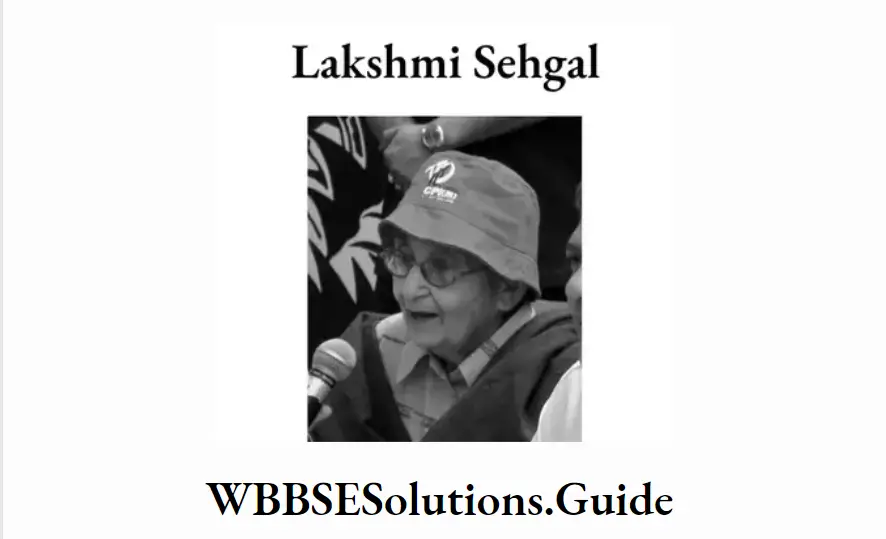
Introduction: Lakshmi Sehgal, also known as Captain Lakshmi (born October 24, 1914, in Madras, Madras Presidency, British India), was an activist of the Indian independence movement, an ex-officer of the Indian National Army, and the Minister of Women’s associations in the Azad Hind Government.
Political Activities: Lakshmi Sehgal later became involved in politics in independent India, was allocated as a member of parliament in the Upper House, and later ran for President as a left-wing candidate. Lt. Col. Swaminathan is commonly referred to as Captain Lakshmi in India, referring to her rank at the time of individual taken prisoner in Burma, as widely reported in Indian newspapers at the end of the war and which captured the public thoughts, as opposed to her not widely known support in the last days of the Azad Hind.
Service of POWs: In 1942, during the historic surrender of Singapore by the British to the Japanese, she worked hard to serve the prisoners of war who were hurt during the skirmishes. In the process, she came in contact with many Indian Prisoners of War (POWs) who were thinking of forming an Indian liberation army.
INA and Lakshmi Sehgal: Subhas Chandra Bose arrived in Singapore on July 2, 1943. In the next few days, at all his public meetings, Netaji spoke of his determination to raise a women’s regiment, the Rani of Jhansi Regiment, which would also “fight for Indian Independence and make it complete”.
Lakshmi wasted no time in joining the new regiment, called the Rani of Jhansi Regiment. She was given the rank of a Colonel. The unit had the strength of a Brigade. In a regular army, this women’s army unit was the first of its kind in Asia. Lakshmi was active both militarily and on the medical front.
She played a heroic role not only in the fighting. Later, she became the Minister-in-Charge of the Women’s Organization in Arzi Hukumate Azad Hind (Provisional Government of Free India), led by Subhas Chandra Bose.
Arrest: Lakshmi Sahgal held this portfolio over and above her command of the Rani of the Jhansi Regiment. Lakshmi was captured and brought to British India on March 4, 1946, where she received a heroine’s welcome. The British realised that keeping her a prisoner would prove counter-productive, and she was later released.
Question 10. Write a note on Leela Roy.
Answer:
Leela Roy
Leela Roy (maiden name Leela Nag) was a radical leftist Indian politician and reforme, and a close associate of Netaji Subhash Chandra Bose.
Early Life: She was born in Panchgaon of Sylhet, Bangladesh. Her father was Girish Chandra Nag. She passed the B.A. degree in English from Bethune College with ‘A Padmavati gold medal’ and passed the M.A. from Dhaka University with first class in English literature. She got married to Anil Roy (13.5.1939), and they joined the ‘Forward Bloc’ of Netaji.
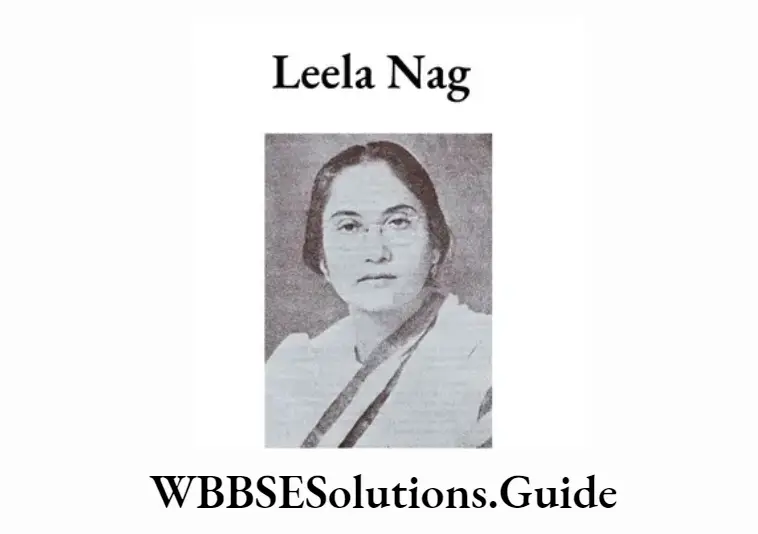
Activities: Leela Nag formed a rebellion organization called Deepali Sangha,, where combat training was given. Pritilata Waddedar took courses from there. She took part in the Civil Disobedience Movement and was imprisoned for six years.
In 1938, she was nominated by Congress Presidet, Subhas Chandra Bose to the National Planning Committee of the Congress. In 193,9 she married Anil Chandra Roy. On Bose’s resignation from Congress, the couple joined him in the Forward Bloc.
In 1941, when there was a serious outburst of communal rioting in Dhaka, she,, along with Sarat Chandra Bose, formed the Unity Board and National Service Brigade.
In 1942, during the Quit India Movement, both she and her husband were arrested,, and her magazine was forced to cease. On her release in 1946, she was elected to the Constituent Assembly of India.
“Movements Organized by Women, Students, and Marginal People WBBSE Class 10 solutions”
During the partition violence, she met Gandhi in Noakhali. Even before Gandhiji reached there, she opened a relief center and rescued 400 women after touring on foot 90 miles in just six days. After the Partition of India, she ran homes in Calcutta for destitute and abandoned women and tried to help refugees from East Bengal.
Question 11. What were the contributions of Pritilata Waddedar in the Indian freedom struggle?
Answer:
Early Life: Pritilata Waddedar (5 May 1911 – 23 September 1932) was a Bengali revolutionary nationalist. After completing her education in Chittagong, she attended Bethune College in Kolkata. Pritilata graduated in Philosophy with distinction. After a brief stint as a school teacher, Pritilata joined a revolutionary group headed by Surya Sen.
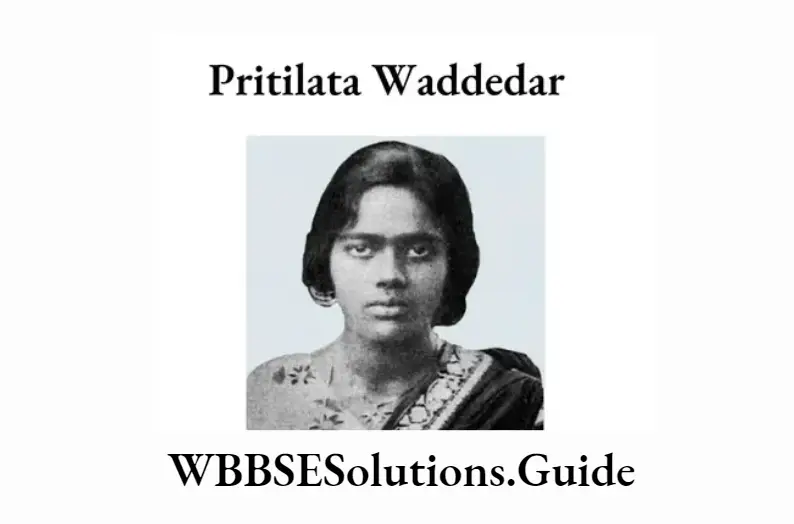
Revolutionary activities: Pritilata decided to join the Indian independence movement. Surya Sen had heard about her and wanted her to join their revolutionary group. On 13 June 1932, Pritilata met Surya Sen and Nirmal Sen in their Dhalghat camp.
A contemporary revolutionary, Binod Bihari Chowdhury, objected that they did not allow women to join their group. However, Pritilata was allowed to join the group because the revolutionaries reasoned that women transporting weapons would not attract as much suspicion as men.
Inspiration from Ramkrishna Biswas: Surya Sen and his revolutionary group decided to kill Mr. Craig, Inspector General of Chittagong. Ramakrishna Biswas and Kalipada Chakravarty were assigned to this task.
But they mistakenly killed the SP of Chandpur and Traini Mukherjee instead of Craig. Ramakrishna Biswas and Kalipada Chakravarty were arrested on 2 December 1931. After the trial, Biswas was ordered to be hanged till death and Chakravarty to be exiled to Cellular Jail.
Their family and friends lacked the amount of money required to travel from Chittagong to Alipore Jail of Calcutta. Since, at that time, Pritilata was staying in Kolkata, she was asked to go to Alipore Jail and meet Ramkrishna Biswas.
Activities in Surya Sen’s group: Along with the revolutionary group of Surya Sen, Pritilata took part in many raids like attacks on the Telephone and Telegraph offices and the capture of the reserve police line.
In the Jalalabad battle, she took the responsibility of supplying explosives to the revolutionaries. She led a 15-man team of revolutionaries in a 1932 attack on the Pahartali European Club, which had a sign board that read “Dogs and Indians not allowed.” The revolutionaries torched the club and were later caught by the British police. To avoid getting arrested, Pritilata consumed cyanide and died.
Question 12. Write a brief note on students’ participation during the struggle for freedom in India.
Answer:
Students’ Participation in India’s Freedom Struggle: India, like all other developed nation,s has a long history of student movement. The youth participation during the struggle for Indian independence surely deserves a mention in any article on students’ contribution to social causes. During the time of independence, Mahatma Gandhi called up the students of the country to participate actively in the struggle for freedom.
Young students from all over the nation sacrificed their careers and plunged into the street,ts protesting against the wrongs of the British government. Young leaders like Nehru led the movement, and we know how students left the British schools and colleges and did away with foreign products.
During the partition of Bengal in 1905 by Lord Curzon, it was the students who took the lead. Popularly known as the Swadeshi Movement, it was majorly led by the students who went for a total boycott of British goods and sought to revive the traditional and domestic products of the country.
It was the students who stopped using British papers and picketed the shops selling British goods. Even during the Non-Cooperation Movement, the Civil Disobedience Movement, and the Quit India Movement, which finally forced the British to leave this country, we see massive student participation. Patriots like Bhagat Singh, Khudiram Bose, and many others who gave up their lives for independence also came from student backgrounds.
Question 13. What were the aims of the formation of the Anti-Circular Society?
Answer:
Formation: Sachindra Prasad Basu formed the Anti-Circular Society on 4th November 1905. Sachindra Prasad, a follower of Rashtraguru Surendranath Banerjee, formed this society when he was a 4th-year student of Ripon College. So, Sachindra Prasad Basu was arrested by the police and sent to Rawalpindi prison.
Purpose: The main purposes of forming the Anti-Circular Society were:
- To formulate a national education policy based on the new feeling of nationalism,
- To boycott foreign education and make people interested in Indigenous education,
- To inculcate interest in Swadeshi education,
To enthuse national leaders to formulate national education policy as a protest against the partition of Bengal, (v) to help the rusticated students to continue their education. The Carlyle Circular forbade the slogan of ‘Vande Mataram’ of Salutations to the Mother.
People joined the Anti-Circular Society as a protest against this also. An important branch of this society was the Defence Association, its president and secretary were Aurobindo Ghosh and Sukumar Ghosh, respectively. Its only mouthpiece was ‘Sanjibani’ edited by Krishna Kumar Mitra.
Question 14. State the character of students’ participation in the armed revolutionary movement.
Answer:
Students’ Participation in Armed Revolutionary Movement: Some special characteristic features of students’ participation in the armed movement of the twentieth century can be noted,
Remained in the Forefront: Since the leadership of the Students’ Movement was in the hands of national leaders, the students remained at the forefront of national and armed revolutionary movements. They used their gut feelings and initiative to make instant decisions and run the movement whenever necessary.
During the National Freedom Movement, when there were differences of opinion between the leftists and the rightists, the students remained united in their progressive and leftist ideals and sacrificed a lot for the cause. In the changed circumstances, it was the students from Bengal who participated in the armed movement with secular and non-communal attitudes.
Students’ Terrorism: The young revolutionaries did not try to plan a violent revolution in the country involving the masses. The idea of the young revolutionaries was to strike terror in the hearts of the alien rulers.
Though the immediate goal was to put an end to the British rule, the revolutionaries could not set forth any alternative plan of government that would take over immediately after the British withdrawal. The student revolutionaries mostly belonged to middle-class families, and the,s a vast majority of common people remained outside its purview.
Swadeshi and Boycott Movements: During the Swadeshi Movement, a boycott of foreign goods and the awakening of extreme nationalism inspired the students to participate in the armed movement. The students were also influenced by Socialism, Russian Revolution, Democracy, and Revolutionist ideas and started participating in the armed movements.
Nature: The nature of the armed students’ movement was based on revolutionary ideals. So they were in contact with secret organizations of the revolutionaries. That way,, neither Congress nor Communists nor any other political party could influence them. Whenever there was a change in the political scenario, the character of the armed revolutionary students’ movement also changed.
Question 15. Write a note on Bengal Volunteers.
Answer: Bengal Volunteers:
Introduction: Hemchandra Ghosh, a young man from Barishal, formed ‘Bengal Volunteers’ (B. V.) in 192, with a handful of local youth. The head office of this organization was in Dhaka. He was inspired by Swami Vivekananda, Aurobindo Ghosh, and Brahmabandhab Upadhyay in forming this group. He got help from revolutionaries like Khagen Das, Suren Barman, and Krishna Adhikari.
Three Organisations: While maintaining the secrecy of their revolutionary activities, the B.V. party formed three social welfare organizations during 1921-22, namely, ‘Social Welfare League’ ‘Sri Sangha’ and ‘Dhruba Sangha,’ to undertake various public welfare activities. Many young men from Dhaka and a lady worker named Leela Nag (Roy) became members of the B. V. party. The monthly journal of this party was called ‘Benu.’
Other Members: Hemchandra Ghosh was the chief whip of the party. However, no one person was responsible for anything in the party. The members worked together as a group.
Apart from Hemchandra, the other important organizers were Haridas Dutta, Satya Gupta, Supati Roy, Satyaranjan Bakshi, Meera Dasgupta, and Jyotish Joardar. B.V. Party had some branches all over Bengal.
The members of the B. V. Party started ‘Operation Freedom’ in 1930 to protect against the oppression of police on prisoners.
Corridor Warfare: Binoy, Badal, and Dinesh started their Writers’ Building campaign on 8th December 1930 and killed the Inspector General of prison, Mr. Simpson. It was reported by The Statesman as ‘Corridor Warfare’. Between 1930 and 1935, there were some revolutionaries in the party.
They were Dinesh Gupta (founder of B. V. in Midnapur), Binoy Basu (killer of Simpson), Produoy Bhattacharya and Nripen Dutta (killers of Douglas), Anath Bandhu Panja (killer of Barge), Moti Maliick (killer of the village guard) and Bhabani Bhattacharya (killer of the Governor of Lebong). Many members of B.V.
Were jailed in the Andamans and Bangladesh. In 1937, all the members of B.V., under the leadership of Hemchandra himself, joined the Forward Bloc party of Subhas Chandra Bose.
Question 16. Write the contributions of students in the Non-Cooperation Movement.
Answer:
Contribution of Students in Non-Cooperation Movement:
1. Introduction: At the Annual Conference of Congress at Nagpur in December 1920, it was decided to start the Non-Cooperation Khilafat Movement to achieve independence. Hindu-Muslim unity and awakening were a direct outcome of this decision.
2. Students’ Activities: During the movement, this student mostly engaged in boycotting schools and colleges, strikes, street corner meetings, non-cooperation, and non-violence.
The non-communal character of students’ movement was intact till then. Many students who joined the Non-Cooperation Movement promised themselves that they would not return to their classes till independence was achieved.
3. Leadership: In Bengal, during the Non-Cooperation Movement, it was decided to launch strikes and boycotts under the leadership of Subhas Chandra Bose (1921).
‘Deshapran’ Birendranath Sashmal led the school and college students of Midnapur in the Non-Cooperation Movement. The main characteristic feature of the students’ movement in Bengal during the Non-Cooperation Movement was that the national students’ organization was yet to be formed.
4. Calcutta Students Association: Two years after the Non-Cooperation Movement, ‘The Calcutta Students Association’ (1924) was formed under the leadership of Biren Dasgupta. Non-Cooperation Movement was a success,s although there were no student organizations present at that time.
The students followed Gandhiji in his path of non-violent satyagraha and introduced mass following in anti-British protests. This was possible because of the non-communal character of the movement.
Question 17. Write the role of women in the Quit India Movement.
Answer: Role of Women in the Quit India Movement: Women’s participation in the Quit India Movement took various forms in rural and urban areas of the country. While in the rural areas, the peasant women protested against the prevalent land system in city areas, the message of the fight for freedom was propagated through radio transmitters,
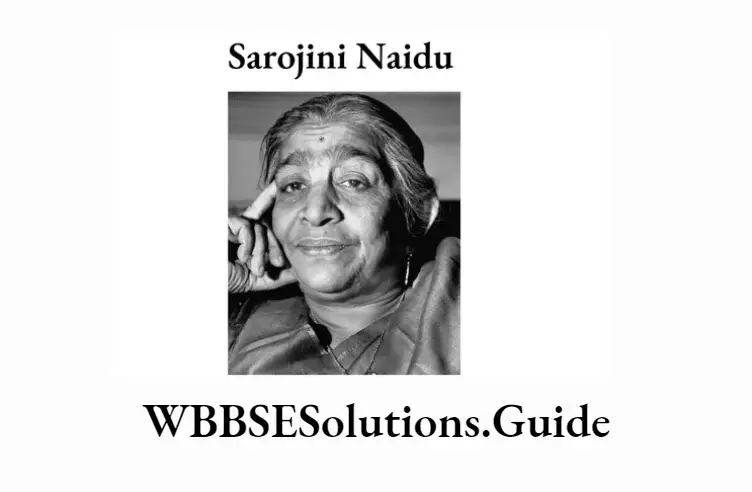
Rural Areas: In the rural areas, the peasant women joined the men in lodging protests against the hike in land revenue and other taxes imposed illegally. Also, the women protested against the landholders’ rights.
Midnapur: In the Midnapur district of West Bengal, during the Quit India Movement, the peasants attacked the police stations, and even the communication network was disrupted by destroying telegraph lines
Matangini Hazra: The incident that immortalized Midnapur in the history of the freedom movement was the lead given by Srimati Matangini Hazra, a 73-year-old widow, in capturing the court and the police station of Tamluk.
Usha Mehta: Usha Mehta, a patriot to the very core of her heart, set up a radio transmitter known as the Voice of Freedom. She intended to circulate information about the war of freedom amongst the people of the country. Usha persisted with her task of broadcasting until she was arrested by the British police (12 November 1942) on the charge of sedition.
Contribution of Devadasis: Apart from these, Devdasis from West Godavari and Maharashtra and women from red-light areas in Bengal, in the interests of the movement, gave up their jewelry and personal belongings in response to a call from Gandhiji. This was another aspect of the movement.
Sarojini Naidu: Sarojini Naidu, also known as the ‘Nightingale of India,” while leading the campaign to capture Dharsana salt godown in May 1930, told her women force, “The honor of India is now in your hands, so do not resort to violence under any circumstances.” The role of the ‘Mahila Atmarakhsha Samity’ or Women’s Self-Defence Society deserves credit. In the history of the women’s movement, the role of women’s organizations in preventing famine and directing the freedom movement will be remembered at all times.
Question 18. Discuss the women’s participation in the Civil Disobedience Movement.
Answer: Women’s Participation in the Civil Disobedience Movement: The Non-Co-operation Movement was suspended by Gandhiji in 1922. However, its suspension found its stronger follow-up in the Civil Disobedience Movement (1930). Participation of women in the Civil Disobedience constituted an important chapter in the history of women’s struggle in the freedom movement.
Role in Picketing: Between 1930 and 1932, women in many places played an important role as they conducted picketing in front of the shops selling foreign goods
Various Forms of Agitation: Women’s participation in the Movement, however, took various forms. While Parsee and Christian women residing in Bombay advocated female education, the Gujarati women, under the influence of Gandhiji, aimed at the attainment of Swaraj and women’s freedom.
In Bengal: In Bengal, women leaders like Kumudini Bose, Latika Ghosh, and Hemalata Tagore made sincere efforts to promote women’s welfare and training of women in some useful crafts.
In U.P.: Swarup Rani Nehru, Jawaharlal Nehru’s mother, burdened with age, did not hesitate to vote for Khadi in the streets. Thus, Gandhiji’s Civil Disobedience found wonderful response from the Indian womenfol.k
Contribution of Devadasis: Apart from these, Devdasis from West Godavari and Maharashtra and women fromred-lightt areas in Bengal, in the interests of the movement, gave up their jewelry and personal belongings in response to the call from Gandhiji. This was another aspect of the movement.
Sarojini Naidu: Sarojini Naidu, also known as the ‘Nightingale of Indi,,’ while leading the campaign to capture Dharsana salt godown in May 1930, told her women-force, “the honor of India is now in your hands, so do not resort to violence under any circumstances.”
Equality of Women: Certain events like the International Conference on Equality of Women in Geneva (1931), the proposal of women’s equality adopted by the Communist Party of China, and ‘The Asian Women Equality Congress’ in Lahore helped to spread women’s rights issues in Civil Disobedience Movement.
WBBSE Chapter 7 Movements Organized By Women, Students, And Marginal People In 20th Century India: Characteristics And Analyses Long Answer Questions
Question 1. Write about the role of women in the armed revolutionary movement in India. What was the role of Deepali Sangha in this connection?
Answer:
Role of Women in the Armed Revolutionary Movement:
Introduction: It is noted in history that men and women had fought together in the armed revolutionary movement in India. If we analyze the characteristic features of the movement, it will be observed that women started showing interest in armed revolution towards the last part of the nineteenth century.
This era was called the ‘Age of Freedom of Captive Women.’ Women had actively taken part in armed movements during the period from the first decade of the twentieth century to the third decade.
Reason For Women’s Participation: The women were self-confident and were ready to sacrifice themselves. That was the reason for their participation in the movement. The spread of education helped to arouse such a revolutionary spirit among women.
Women’s movement, as a protest against the wrongful oppression of women, had two main branches: one was a nonviolent protest, and the other was an armed revolutionary movement.
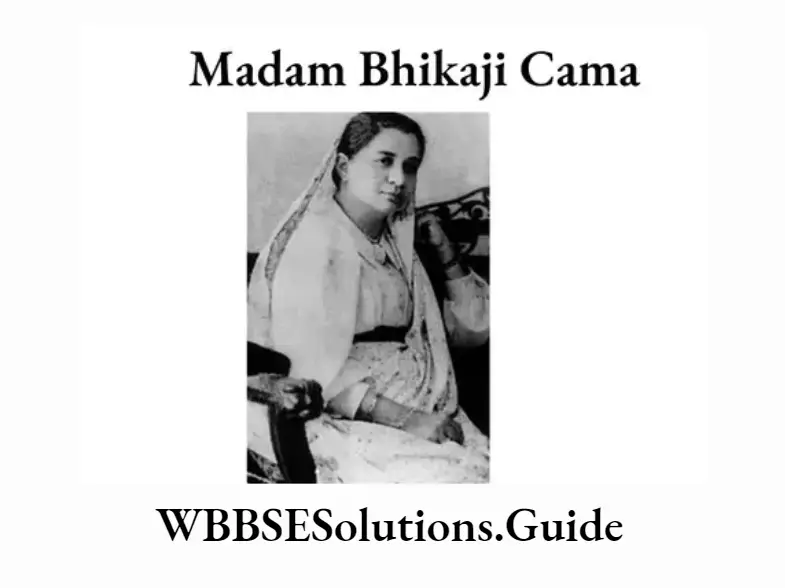
Various Activities: The women were inspired by the regeneration, the spread of education among women, nationalist feelings, and patriotism in general, and joined the armed movement to free the Motherland from captivity. Gandhiji iterated in the journal ‘Young India’ that it was essential for women to join the movement to free their Motherland.
The direct role of women in this movement was to boycott all foreign goods, picketing, and fasting. While indirectly, it was their duty to secretly supply arms to the revolutionaries, pass information from one source to another, safeguard houses, and protect the revolutionaries from police in different ways.
Mrs. Vikaji Rustamji Kama, who is known as the mother of Indian revolutionary ideals, told a gathering outside India in 1910, “Remember, the hand that rocks the cradle rules the world. These soft hands build the national character. So, please do not ignore these strong hands”.
Women’s Brigade in Azad Hind Fauj: The women’s brigade of Azad Hind Fauj was called the ‘Jhansi Brigade.’ Netaji Subhas Chandra Bose vested the leadership of this women’s brigade in Smt. Lakshmi Swaminathan (24.10.1914-23.07.2012). Later, she became Lakshmi Sehgal.
She was a true revolutionary in the Indian Freedom Movemen, who was the Minister of Women’s Affairs in the Azad Hind Government. Towards the end of World War II, she was imprisoned in a jail in Burma under the name of ‘Captain Lakshmi’.
Lakshmi, who hailed from the Malabar region, had passed the MBBS Examination at ‘Madras Medical College’ before she took charge of the women’s brigade of Azad Hind Fauj at Netaji’s call.
“WBBSE Class 10 History Chapter 7 question and answers, Characteristics and Analyses”
Dr. Lakshmi Swaminathan took charge of the ‘Jhansi Brigade,’ comprising 856 women, on 16th July 1943. Her crusade against the British started on 23rd October. Lakshmi Swaminathan made the ‘Jhansi Brigade’ ever stronger by recruiting voluntary women from Burma and Malay. In March 1946, Lakshmi Swaminathan was arrested and kept in the Red Fort, Delhi.
Armed Movement During Anti-Partition of Bengal Movement: Women started leaning towards armed movement during the Anti-Partition of Bengal Movement in 1905. From 1910, upper-class, educated women started forming various social organizations.
Bina Das got her inspiration for the armed movement from the students’ organization of which she was a member. In Komilla, school students Suniti Chowdhury and Shanti Das assassinated District Magistrate Stevens on 14th December 1931 and were sentenced to life imprisonment.
Parul Mukherjee was convicted in the ‘Titagarh Conspiracy Case’ and sentenced to three years in jail. But from the time of World War II, many peasant women became involved in the movement. FromTebhaga Movemen,t the nature of women’s participation had undergone a sea change.
Adivasi, Tribal, Namashudra, Scheduled Caste, and Muslim women followed the path of armed resistance, ignoring the police and administration’s brutalities. Ila Mitra, Rina Guha, and others were fire-brand leaders of the Tebhaga Movement (1948-49).
Deepali Sangha (1923): In December 1923, Leela Nag (Roy) {2.10.1903.-11.06.1970} established ‘Deepali Sangha’ in Dhaka consisting of 12 members. She passed the B. A. degree in English from Bethune College with a ‘Padmavati gold medal’ and passed the M. A. from Dhaka University with first clast in English literature. She got married to Anil Roy (13.5.1939), and they joined the ‘Forward Bloc’ of Netaji. The organization had played a vital role in the emancipation of women of Bengal. With the initiative of Deepali Sangha.
- A Girls’ High School.
- An Adult Education Centre and
- 15 Primary Schools were opened.
These educational institutions were run by the ladies of Deepali Sangha. Apart from this, Deepali Sangha also organized exercise and physical education for women.
One of the main aims of Deepali Sangha was to inculcate the spirit of patriotism among women. Leela Roy founded ‘Deepali Chhatri Sangha’ in 1926, the first female students’ organization in India, and introduced the practice of politics among women.
She founded ‘Chhatri Bhavan’ in 1930 and edited a monthly magazine ‘Javashri’ in 1931. She was arrested in 1931 and was imprisoned up till 1938.
Question 2. Write about the characteristic features of the student’s movement in the twentieth century.
Answer:
Introduction: The student movement began in India in the second half of the nineteenth century. The editor of Hindu Patriot, Harish Chandra Mukherjee, and eminent writers like Girish Chandra Ghosh, Bankim Chandra Chattopadhyay, and Rangalal Banerjee wielded the pen to instill patriotism among the students.
Characteristics and Features:
1. Anti-British Political Movement: If we analyze the growth of the students’ movement during the twentieth century, one of the most notable features that will be observed is that, from the Partition of Bengal to World War I (1905-1918), the main basis of students’ movement was an anti-British political movement.
Spontaneous protests of individuals culminated in a united and well-organized student movement. The students of Brajamohan College, founded by Aswini Kumar Dutt,a took part in the freedom movement in 1905. Khudiram Bose and Prafulla Chaki were accused of their attempt at the murder of Kingsford.
2. Leadership and Secular Character: They also conducted the movements by themselves whenever it was needed. During the freedom movement, when there were idealistic differences of opinions between the left and the right-winged politics, the students got involved whole-heartedly.
The students’ movement of this time was also noted for its secular and non-communal character. It was free from all kinds of conservative ideas and the influence of national leaders. The students primarily protested against unfair dealings, injustice, discrimination, and deprivation in society.
3. Boycott and Revolutionary Activities: Their self-sacrifice, service, fearlessness, and truthful, progressive nature gave a unique character to the students’ movement.
Students’ Movement before 1919 had two main features, namely, during the Swadeshi period, their extreme enthusiasm about boycotting British goods helped to enhance anti-British feelings all around; and secondly, the young student community was greatly influenced by revolutionary movements, Russian Revolution (1917) and equality and socialist ideals.
4. Agitation of College Students: The students’ movement during 1918 and 1939 was marked by different features. According to a Government Report, 190 national schools and colleges and their 15,000 students joined the anti-partition movement.
Jatin Das, the President of the Students’ Union of Bangabasi College, died in Lahore Jail after 64 days of fasting. At that ti,me the founder of ‘Nao Jawan Bharat Sabha’, a college student Bhagat Singh was hanged on 23rd March 1931 at the end of the trial “Lahore Conspiracy Case” (1929-31).
From the movement protesting against the Rowlatt Act of 1919 to the Civil Disobedience Movement of 1933, the students started a larger movement through their organization and independent demands.
5. Movement of, by, and for the Students: We can say that it was a movement of the students, for the students, and by the students, directed towards the well-being of the people in general. On 6th April 1919, a students’ strike took place across the country from Lahore to Kanyakumari and from Bombay to Calcuta, against the Rowlatt Act.
Gandhiji was arrested during the strike. Students from all communities, Hindu, Muslim, and Sikh, brought out processions and organized meetings.
6. Students’ Organisations: Khusiram was the first student martyr from Punjab who died from police bullets. Over time, the need for their political agenda and organization was felt among the students, so student organizations like Lahore Students’ Union (1927), Ali India Students’ Federation (1936), Delhi Students’ Union (1931) and Indus Students’ Union were formed.
Students’ Movement of Bengal was a part of the National Movement, yet it lacked proper direction because the student leaders became divided into two groups in 1929.
All Bengal Students’ Association (ABSA) was formed under the leadership of Jyotindra Mohan Sengupta,, and the Bengal Presidency Students Association was formed under the leadership of Subhas Chandra Bose.
7. Difference of Opinion: Differences of opinion and clashes between the leftists and the rightists marked the students’ movement in the post-World War II period. The character of the movement itself changed because of the political scenario in this period. AntiFascist students’ movement became the order of the day.
This continued from 1935 to 1946. However, this movement did not take place in all the provinces of India. On 27th November 1933, Romain Rolland warned the students of India about the dangers of Fascism. This supplied oxygen to the anti-Fascist students’ movement in India.
Question 3. Write about the role of students in the Anti-Partition of Bengal Movement. Assess the students’ movement of the twentieth century.
Answer:
Students Movement during the Anti-Partition Movement of Bengal:
1. Introduction: When Lord Curzon planned to partition Bengal (16th October 1905), the students’ movement went into turmoil, not only in Bengal but also in other places. The most important aspect of the movement was that the Hindu and Muslim students fought together.
2. Procession and Boycott: At the initiative of Ripon College (present Surendranath College) of Calcutta, 5,000 students took out a procession and had a meeting in College Square as a protest against the partition of Bengal.
Barristers Abdul Rasul and Liaquat Hossain addressed the meeting. During the Anti-Partition of Bengal Movement (1905-11), students, teachers and intellectuals assimilated. Another important aspect of the students’ movement during this period was a boycott of all foreign goods and picketing.
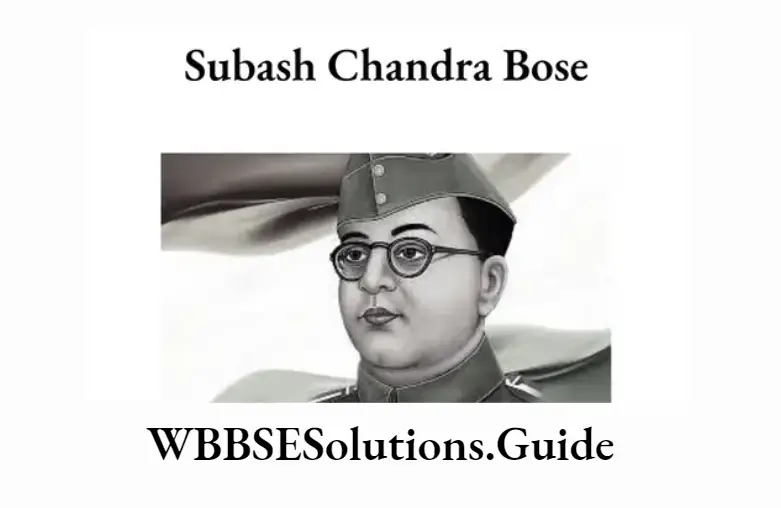
3. Revolutionary Activities: A significant characteristic of the students’ movement at that time was revolutionary activities and secret organizations like Anushilan Samity and Jugantar Dal. Khudiram Basu, a student of Hamilton School of Midnapur, in an attempt to assassinate Magistrate ‘Butcher’ Kingsford, inadvertently killed Miss and Mrs. Kennedy (1908).
Students’ Movement in Bengal at that time was led by people like Surendranath Banerjee, Ananda Chandra Roy, Aswini Kumar Dutta, Ambika Charan Majumdar, Umesh Chandra Gupta, Kishorimohan Chowdhury and Anathbandhu Bipin Chandra Pal.
So, while analyzing the students’ movement, it can be said that the Government was under great pressure and had to remove their capital from Calcutta to Delhi in 191,2 and the decision for partition of Bengal was annulled on 12th December 1911.
Significance: The students’ movement in the twentieth century had a tremendous significant,ce which can be noted from the following points
Empowerment to Freedom Movement: The students’ movement empowered the Freedom Movement of India.
- Anti-British Movement: Although it was primarily directed by the students, the movement always manifested itself as an anti-British movement
- Growth of Students’ Politics: While the students’ movement was,, on one hand, helpful in the growth of students’ politics, on the other hand, it helped to consummate India’s Freedom Movement
- Inspiration: The progressive, spirited, fearless, self-sacrificing, and revolutionary nature of the movement had kept many national leaders in a spirited form.
- Students Organisation: Inspired by the movement, many student organizations were established,d, and they kept their mark in the country through their service and social work.
- All India Students Federation: Dr. Bidhan Chandra Roy, while addressing a meeting of the Students’ Federation in December 1944 at Mohmmad Ali Park, told the gathering, “All India Students’ Federation deserves to be commended for their services during famine and epidemic.”
- Evolution of Future Political Personnel: Many eminent politicians, leaders, ministers, and administrators have evolved out of students’ movements and students’ politics. Whatever way the students’ movement of the twentieth century is presented in the pages of history, barring a few exceptions, it was a good thing that happened in our country.
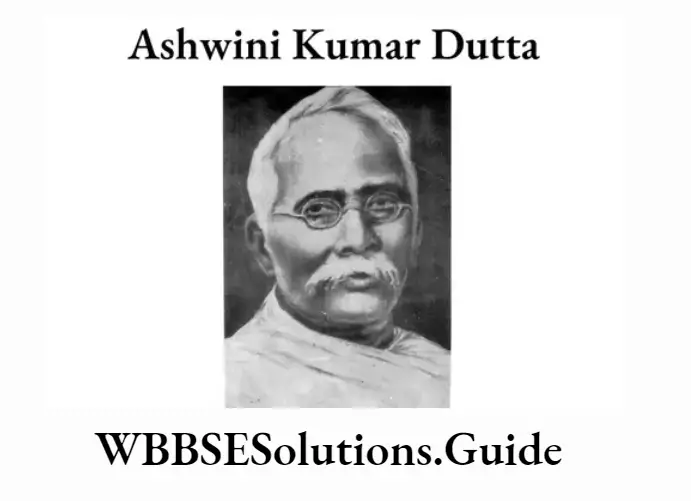
Question 4. Write about the development of Dalit politics in twentieth-century India.
Answer:
Dalit Politics in Twentieth-Century India:
Introduction: ‘Dalit’ is a Hindi word. It has been used in India for a very long time. The extremely poor people, who are deprived of human rights because of forceful oppression, are called ‘Dalits’. In a journal edited by Dr. B. R. Ambedkar, the Depressed Classes of British rule have been called ‘Dalit’.
Initial Activities: The Dalit people of India have been prey to economic, social, political, and cultural deprivation as a result of century-old apartheid issues. The first person to start a movement in Maharashtra was Mahatma Jyotiba Phule (1872), who formed ‘Satya Shodhak Samaj’ in 1873. Dalit politics and movement started taking shape and extended with the initiative of his follower, Dr. Bhimrao Ramji Ambedkar.
From 1924 to 1930, he transformed the Dalit Movement into a radical movement’ The main purpose of his movement was to end the social problems and deprivation faced by the Dalit people. Ambedkar led and organized movements like the Choudar Lake Movement and Kalaran Satyagraha.
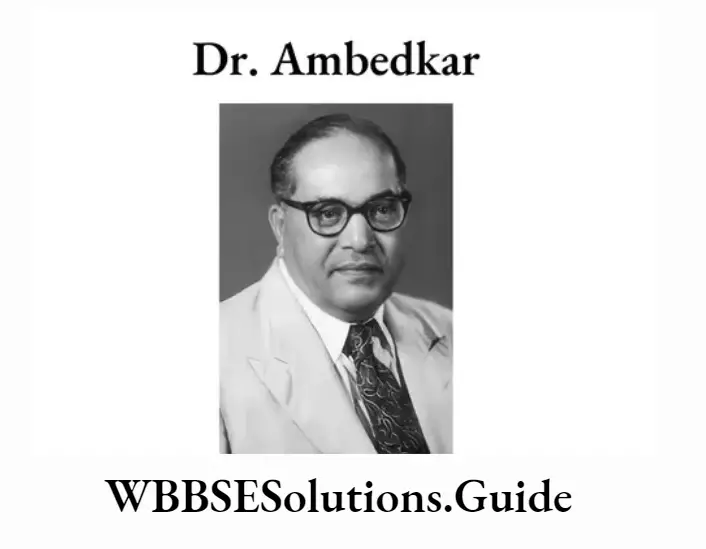
Demand for Separate Electorate: V. R. Shield founded ‘The Dalit Mission Society’ in 1906. Its president, N. G. Chandravarkar, demanded from the British a separate electorate for the backward Dalits. In 1918, the India Dalit conference was held. But Dr. Ambedkar officially convened the first ‘All India Dalit Conference’ on 30th May 1920.
Religious Discrimination: The untouchable Dalits were not allowed inside Kalaram Temple in Nasik. As a result, the Dalit Movement was given a religious character. A memorandum was signed in the presence of Sankaracharya of Kanch,i and it was decided that the Dalits would be allowed to enter the temple and also hold the holy ropes during Rath Yatra Festival. But, finally, the upper caste Fiindus did not allow that to happen. Ambedkar, along with lakhs of followers, embraced Buddhism on 14th August 1956. He felt that Buddhism was the true alternative to Brahmanical practices.
Inspiration From Black Panther Rebellion: During the 1960s, the movement to safeguard the rights of the Dalits had started. It was mainly to safeguard social and economic rights. This movement was influenced by the ‘Black Panther Rebellion’ of America. In India, the Dalit ‘Panther’ had a militant political agenda.
Demand of Protesters: The protesters demanded equal distribution of land, an increase in the rates of daily wages, a chance for free schooling of children, and stopping economic oppression. Later on, the ‘Bahujan Samaj Party’ (BSP) adopted the programs like ‘Dalit- Culture Preservation Bill’ and ‘Ambedkar Village Programme’
Growth of Dalit Movement: On 9th July 1972, Namdeb Dhamal, Daya Pawar, Ramdas Sorte, J. V. Pawar, and Arjan Dangle started a movement called ‘Dalit Panther’. Dalit literature movement spread across India through ‘The D.S-4 Movement’ and through ‘The Republican Party of India’ (RPI) formed by Ambedkar.
D.S-4 stands for’Dalit-Shoshit-Samaj-Sangharsh-Samity’. This movement had been very popular in Maharashtra, Karnataka, Andhra Pradesh, and Madhya Pradesh. Dalit thoughts received national stature through the fortnightly journal ‘Dalit Voice’,’edited by the national journalist V.T. Rajshekhar and published from Bangalore.
Gayle Omvet, in his book ‘Dalit Vision,’ has vividly analyzed the social and political reality faced by the Dalit community. The Dalit Movement of Prof. Yashwant Manohar and its effect on Dalit literature had spread across the country, including Bengal.
Question 5. Write about the controversy between Gandhi and Ambedkar about the rights of the Dalit people. Discuss the origin of the Namasudra movement regarding this.
Answer:
Debate Between Gandhi and Ambedkar Regarding Dalit Rights: There is little doubt that both Gandhi and Ambedkar were very much aware of the problem of the untouchability of the Dalits. Yet there was a sharp difference between the two regarding the Dalit issue.
1. Little in Common: There was little in common in the perception between the two that came to the forefront in the early 30s of the nineteenth century
2. Difference because of Minority: Gandhiji refused to view the Dalits as a minority who should be given political safeguards. Rather, he considered it essentially a social problem, and that was to be tackled by the Hindu community itself.
Contrarily, Ambedka,r describing the dalits as ‘slav,”, advocated for communal representation of the dalits on the ground that ‘untouchability constitutes a definite set of interests which the untouchables alone can speak for.’
3. Split of Opinion: Throughout the 1920s, Ambedkar had a soft spot for Gandhi as he took him as one different from the elitist Brahmanic leaders he (Ambedkar) hated. The real break between the two surfaced during the events of the Round Table Conference of 1932.
4. Separate Electorate: In the two Round Table Conferences, Ambedkar ended up supporting a separate electorate for the untouchables (dalits).
Communal Award and Poona Pact: But this proved to be too much for Gandhiji. For him, the untouchables were a part of Hinduism, and a separate electorate for them would create a division in Hinduism. Subsequent Communal Award and Gandhi’s fast unto death led to the Poona Pact of 1932. It must, however, be remembered that Ambedkar’s agreement in signing the Poona Pact was by no means due to his ‘change of heart’.
It was Gandhi’s ‘pressure tactics’ that compelled Ambedkar to soften his stand and accept the compromise formula of the Poona Pact. Later on, Ambedkar expressed his unhappiness over the issue,e and this, in the long run, increased his bitterness towards Gandhiji.
Namasudra Movement: The poor and uprooted oppressed, untouchable peasants of East Bengal were called ‘Namasudra.’ To protest against the oppression of the upper class was the main cause of the Namasudra Movement. Harichand Thakur (1812-1878) was the founder and leader of this movement in Faridpur. His disciples are called ‘Matua,’ whose aim is to create self-respect and self-consciousness among the ‘Namasudras.’
Harichand told the Matias to observe ‘Twelve Orders’ or conducts during the movement against exploitation by the Brahmins, Zamindars, Priests, etc. He advised the Namasudras to take education and said, “No loss for lack of food, but education is a must for the children”.
Harichand’s son Guruchand (1846-1937) demanded to change the name of the Chandalas to ‘Namasudra’ in 1881. His demand was recognized in the census report of 1911. Therefore, he is called the father of the Namasudra reform movement.
Question 6. What was the role of womenfolk in the Anti-Partition Movement of 1905?
Answer:
Role of Women in the Anti-Partition Movement: One of the remarkable features of the Swadeshi movement, an integral part of the anti-partition movement, was the participation of women. Yet it was limited in extent, as pointed out by Professor Sumit Sarkar; except Saraladebi Choudhurani, no one dreamt of including women in the movement.
1. Role of Sarala Debi: Sarala Debi spread the gospel of nationalism in Punjab and maintained close links with the Suhrid Samiti of Mymensingh (in present Bangladesh), a secret revolutionary society.
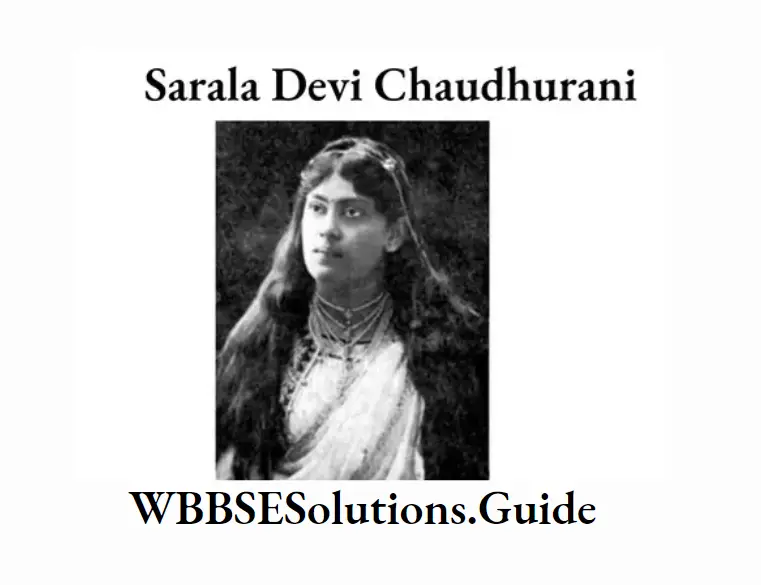
2. Other Women: Recent research, however, revealed that apart from Sarala Deb,i many other women were drawn into the political struggle during the anti-partition agitation. Srimati Hemantakumari Choudhury was the one who edited the journal Antahpur between 1901 and 1904.
3. Protest: The womenfo,lk in gene,ral also did not turn a deaf ear to the anti-partition movement. The day of Partition (16 October 1905) was observed by women throughout Bengal as the day of protest. About five hundred women gathered on the day of Partition in North Calcutta to watch the foundation of the Federation Hall, which was a symbol of unity of the Bengali people.
4. Ashalata Sen: In Dacca, an eleven-year-old little girl, Ashalata Sen, under the inspiration of her grandmother, Nabashashi Sen, went visiting house after h,ouse encouraging women to join the Swadeshi cause
5. Role of Common Women: There are several other instances where even the housewives came out into the open and led processions on the streets. In a similar vein, a good number of women of Khulna attended a meeting addressed by Kaliprasanna Kavya- shared, where the assembled women broke their glass bangles, symbolizing the boycott of foreign goods. Women also played an important role in the revolutionary phase of the anti-partition movement.
Role of Women In the Armed Revolutionary Movement: In the revolutionary struggle, the participation of women presented a different picture than that of the non-violent struggle.
- No Encouragement: Women’s involvement in the non-violent struggle had the support and encouragement of Gandhiji. However, the women who participated in the armed struggle joined it on their own. That is to say, there had been no encouragement from any quarter to enthuse the women to join the revolutionary struggle.
- Secret Societies: In fact, the revolutionary secret societies made no concerted efforts to encourage the participation of women as Mahatma Gandhi had done with non-violent activities.
- Constraints: Another important point to be noted is that direct participation of women in the revolutionary movement was not feasible also due to certain constraints. First, women were not allowed by their male relatives to join the revolutionary secret societies. Second, the risk was too high to allow women to participate in revolutionary feats on an equal basis with men.
- Silent Help: However, in general, the indirect participation of women helped the revolutionaries silently from the background.
7. Write about the participation of women in the Non-Cooperation Movement. What was the importance of Sarojini Naidu’s appointment as the Congress President?
Answer:
Participation of Women in the Non-Cooperation Movement: During 1920-22, many women throughout the country joined the Non-Cooperation Movement.
Gandhiji laid stress on women’s participation through the Khadi movement. He felt that it was important for poor rural women to participate in the khadi and cottage industry because that would make them economically independent.
So, during the Non-Cooperation Movement, the restrictions and parochial ideals of the women’s movement had dispersed to a great extent. Gandhiji said that unless the women worked side by side with men, Mother India would never be freed from her chains.
This time,e Annie Besant, Heerabai Tata, Sithibai Tata, Begum Hamid Ali, Rajkumari Amrita Kaur, and Dr. Muthulaxmi Reddy, a popular physician of Madras, moved demanding voting rights for women. Dr. Reddy put forward a bill to abolish the devadasi system first. She was the first woman member of the Legislative Assembly of India.
“Best solutions for WBBSE Class 10 History Chapter 7, Women and Students Movements”
At this time, the leaders of ‘The Young Women’s Christian Association’ and ‘The Women Indian Association’, like Annie Besant, Margaret Cousins, Kamaldevi Chattopadhyay (1903-1988), and Renuka Roy, became icons of the Non-Cooperation Movement. Kamaladevi was the first secretary and later president of the All India Women Conference’ (ASWC). Renuka Roy, a follower of Gandhiji, became a member of parliament and was the first woman minister of West Bengal.
Gandhiji wrote in an article that it was essential for women to participate in the Non-Cooperation Movement because of the following reasons:
- Impact of Colonialism: Colonial economics has affected the self-dependence and social stand of women.
- Importance of outside connection: It was essential for the women to leave the confinement of their households and connect with the outside world
- Non-Cooperation Movement: Participation of women in the Khadi movement would pave the way for their participation in the nationalist movement, the spinning wheel being the symbol of the Non-Cooperation Movement.
- Encouragement by men: The women were encouraged by men folk to join the movement.
It was not restricted to women of higher class and middle class, but even women from poor backgrounds became interested in spinning and weaving.
6. Boycott and Swadeshi: The negative and positive agenda — boycott of foreign goods and promotion of indigenous industry — greatly inspired women.
Kamala Nehru, the wife of Jawaharlal Nehru, joined the movement. During the movement, 80,000 people were arrested, of which 17,000 were women. Urmila Devi, daughter of Basanti Devi, founded Nan Karma Mandir (1921) in Calcutt,a and Neli Sengupta took the leadership of the Steamer strike.
Similarly, Prabhabati Bose, mother of Subhas Chandra Bose, presided over the women’s State Union to propagate the ideals of the movement in remote villages.
Sarojini Naidu: Sarojini Naidu became the Congress President in 1926. She was the first Indian woman to become the Congress President. The entry of Sarojini Naidu to the high post served as an inspiration to the womanhood of India. The Non-Cooperation Movement was abruptly called off by Gandhiji because of the Chauri Chaura incident. Yet Indian women’s interest in politics did not subside.
Question 8. Write in short about the role of students in the Civil Disobedience Movement. Write in short about the women’s wing of the Indian National Army.
Answer:
Role of Students in the Civil Disobedience Movement:
Introduction: Towards the end of the Civil Disobedience Movement, 1930, students’ unions started developing in places like Kanpur, Lucknow, Aligarh, Allahabad, Bareilly, Barabbabi, Khurja, Meerut and Dehradun after the formation of the Students’ Federation in Uttar Pradesh. These students were revolting off and on, which cannot be called a students’ movement in the strict sense of the term. Gandhiji had said, “In recent years, students were seen at the forefront of any revolution that had taken pla.””.

Nationalist Activities of Students: Indications of the beginning of the Civil Disobedience Movement were clear from the demand for Complete Independence raised in the Lahore Congress (1929). In the wake of the demonstration against the coming of the Simon Commission in 1927, the students of most of the colleges of Calcutta and the suburbs went on strike. It is mention-worthy that the girls of Bethune College, for the first time, joined the strike.
With the outbreak of the Civil Disobedience movement, the student community of Bengal became a formidable force. Between 1930 and 1933,, as many as fifteen thousand students were imprisoned by the British on the charge of violating section 144 or for picketing in front of business establishments.
A remarkable role was played by the students of Midnapur during this phase of the freedom movement. In Taml,uk thousands of students went on strike for long 6 months. During her prosecution, Bina Das said, ‘At all places and all times, students’ community will inspire people to protest against unfairness and injustice/ She wanted the students’ movement to have a revolutionary character.
Women’s Wing of INA: Lakshmi Swaminathan made the ‘Jhansi Brigade’ ever stronger by recruiting voluntary women from Burma and Malay. A woman soldier of the Jhansi Brigade once commented, “We are all ready to die. There is no woman in this brigade who is scared of death”. In March 1946, Lakshmi Swaminathan was arrested and kept in the Red Fort, Delhi.
Question 9. Discuss the role of foreign women in the freedom movement of India.
Answer:
Introduction: Besides the hundreds and thousands of Indian women who dedicated their lives to the cause of their motherland, several noble and courageous foreign women saw in India – its religion, its philosophy, and its culture, hope for the redemption of the world. They thought that in India’s spiritual de,theshall world would find its grave.
Sister Nivedita: Sister Nivedita was one among the hosts of foreign women who were attracted to Swami Vivekananda and Hindu philosophy. Born in Ireland on 28 October 1867, she arrived in India in January 1898 in search of truth. She was impressed by the ideals of womanhood in India.
Activities: On the death of her spiritual Master, Swami Vivekananda, she freed herself from the obligations of the Monastic Order, spoke, and wrote against the British policy in India. She attacked Lord Curzon for the Universities Act of 1904 and the partition of Bengal in 1905.
She held the British responsible for the disastrous state of the Indian economy; she attended the Benares Congress in 1905 and supported the Swadeshi Movement. She helped Nationalist groups like the Dawn Society and the Anushilan Samiti.
She was a member of the Central Council of Action formed by Aurobindo Ghosh and took up the editorship of the Karma yogin when he left for Pondicherry. She propagated the cause of India throughout America and Europe. Swami Vivekananda described her as a real lioness. Rabindranath Tagore regarded her as Lok-Mata and Aurobindo Ghosh as Agni-Shikha.
The Mother: Mira Alphonse, the Mother, was born in Paris in 1978. She had shown the depth of vision and fragrance of expression even in her early childhood. She came to India in 1914 and met Sri Aurobindo. She was associated with the work of Sri Aurobindo when he started a philosophical monthly named Arya on August 15, 1914, to express his vision of man and his divine destiny.
Activities: She took charge of the Ashram in Pondicherry in 1926. She was the inspirer of Auroville, the international town near Pondicherry. It was to serve as a meeting place for the followers of Sri Aurobindo.
“WBBSE Class 10 History Movements by Marginal People, Women, and Students, solved answers”
Mira Behn: Mira Behn, or Mira as she was most often called, was the Western world’s acknowledgment of guilt and the will to atone for it. Gandhi did not evoke her. The most he did was to tell her she could come if she wished.
This is how Madeleine Slade, brought up in an affluent environment of a proud aristocracy, came to serve the cause of India’s freedom by identifying herself completely with the life and work of Gandhi, who promised to Romain Rolland that he would leave no stone unturned, to assist her to become a bridge between the East and the West.
Daughter of a British Admiral, Madeleine Slade renounced the life of luxury and worked in the service of India. She accompanied Gandhi to England in 1931 and undertook a tour of America and Britain in 1934 to enlist sympathy for the Indian cause. She suffered imprisonment in 1932-33 and 1942-44 for the cause of India’s Independence.
Dr. Annie Besant: Dr. Annie Besant, along with Charles Bradlaugh, it is said, did more than anyone had done in a hundred years to break down the barriers of bigotry and prejudic, and won the greatest victories of their times for the freedom of speech and liberty of the press which Britain enjoys today.
Question 10. Discuss the role of some prominent women in India’s struggle for freedom.
Answer:
The role of some prominent women in India’s struggle for freedom
Introduction: The entire history of the freedom movement is replete with the saga of bravery, sacrifice, and political sagacity of the great men and women of the country. This struggle, which gained momentum in the early 20th century,y threw up stalwarts like Mahatma Gandhi, Lala Lajpat Rai, Motilal Nehru, Abul Kalam Azad, C.
Rajagopalachari, Bal Gangadhar Tilak, Gopal Krishna Gokhale, Jawaharlal Nehru, and Subash Chander Bose. Their number and stature often give us an erroneous impression that it was only a men’s movement. But it is not so. Many prominent women played a leading role in the freedom movement.
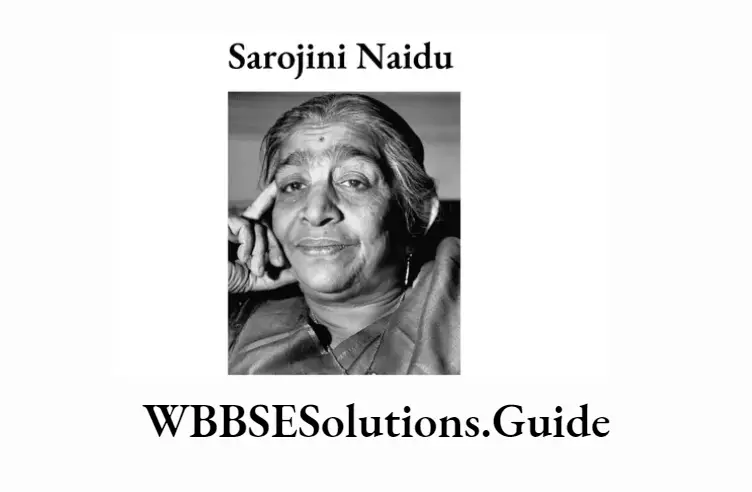
Sarojini Naidu: Sarojini Naidu was known as the “Cuckoo of India.” She was a distinguished poet and a renowned freedom fighter. Her father was the Principal of Nizam College. At that time, Nizam was not in favor of Women’s education, hence Sarojini was sent to Madras for schooling.
She topped the matriculation examination at the age of twelve. Sarojini Naidu was elected as the President of the Indian National Congress. A dramatic meeting with another respected leader of the time, Gokhle, in 1906 was to change her life forever. His response to her fiery speech brought into her life the impact of a visionary who saw in her oratory the brilliance of a leader of the future. The period from 1917 to 1919 was the most dynamic phase of Sarojini’s career.
During this time, she campaigned for the Montague Chelmsford Reforms, the Khilafat issue, the draconian Rowlatt Act, and the Satyagraha. When Gandhi launched the Civil Disobedience Movement, she proved a faithful lieutenant. In 193,0 when Mahatma Gandhi chose her to lead the salt Satyagraha, stories of her courage became legend.
Google advised her to spare all her energy and talents for the nation’s cause. She gave up writing poetry and fully devoted herself to the emancipation of women, education, Hindu-Muslim unity, etc. She became a follower of Gandhi and accompanied him to England. Whenever she was in England, she openly criticized British rule in Ind,ia which caught the attention of scholars and intellectuals.
Aruna Asaf AM: Aruna Asaf Ali, a radical nationalist, played an outstanding role in the historic Quit India Movement launched by Mahatma Gandhi on August 9, 1942, and was a prominent leader of the underground movement. She published bulletins, went from place to place, and even met Mahatma Gan,dhi avoiding arrest. She edited Inqilab, a monthly journal of the India National Congress.
Kasturba Gandhi: The Life Companion of the Father of the Nation contributed her mite to the freedom movement in a subtle manner. As the closest associate of Gandhiji during his epic struggle in South Africa and India, she suffered in no small measure.
Vijay Lakshmi Pundit: Vijay Lakshmi Pundit was the daughter of Motilal Nehru, who was the president of Congress and brother of Jawaharlal Nehru, India’s first Prime Minister.
She was inspired by Rani Lakshmi Bai of Jhansi and impressed by Sarojini Naidu. She entered the Non-Cooperation Movement to fight against the British rule. Vijay Lakshmi represented India in many conferences abroad. She attended numerous public lectures and challenged the British-dominated delegates’ rights to represent India therein.
She was a great fighter and took part in many of the freedom movements. She was arrested in 1932 and sentenced to one year’s rigorous imprisonment. She was arrested in 1940 and yet again during the Quit India Movement in 1942.
Madam Cama: Madam Cama fought for the freedom of India till her last breath in her wayand helped many revolutionaries with money and materials. She unfurled the first National Flag at the International Socialist Conference in Stuttgart (Germany) in 1907. She traveled to a lot of places, including Americ,a and propagated among Americans about Indians struggling for Independence.
Swarup Rani and Kamala: The mother of Jawaharlal Nehru, Swarup Rani Nehru,, cheerfully gave her husband and children to the country’s cause, and herself, old and trail, entered the prayer at its thickest. Jawaharlal’s brave wife, Kamal,a kept smiling all through the long years of her brief life.
Kamala Nehru was a flame that flickered briefly in the raging storm of the freedom movement in India. Not everybody knows that she braved lathi charges, picketed liquor shops, and languished in jail for the cause of Indian independence.
She influenced her husband Jawaharlal and stood by him in his determination to plunge into the movement started by Mahatma Gandhi to free the motherland from the clutches of the British rulers.
Kamala Nehru was the first among the group of volunteers to sell contraband salt during the Salt Satyagraha. All through the long months of 1930, the Desh Sevika Sangh, which she led along with Kasturba Gandhi and Sarojini Naidu, did hard jobs like policing the disturbed areas in Bombay. While the men were in jail, they took over.
Padmaja Naidu: Sarojini’s daughter,r Miss Padmaja Naidu,, devoted herself to the cause of the nation like her mother. At the age of 21, she entered the national scene and became the joint founder of the Indian National Congress of Hyderabad. She spread the message of Khadi and inspired people to boycott foreign goods.
She was jailed for taking part in the Quit India movement in 1942. After Independence, she became the Governor of West Bengal. During her public life spanning over half a century, she was associated with the Red Cross. Her services to India and especially her humanitarian approach to solving problems will always be remembered.
Indira Gandhi: The most remarkable woman in modern India was Indira Gand, who, from her early years,s was active in the national liberation struggle. During the 1930 movement, she formed the ‘Vanar Sena,’ a children’s brigade to help freedom fighters.
She became a member of the Indian National Congress in 1938.
Soon after her return to India in March 1941, she plunged into political activity. In the eventful years of her leadership as Prime Minister, Indian society underwent profound changes. She was unremitting in her endeavor for the unity and solidarity of the nation.
A staunch defender of the secular ideals of the Constitution, she worked tirelessly for the social and economic advancement of minorities. She had a vision of a modern, sself-reliantnot, and dynamic economy. She fought boldly and vigorously against communalism, obscurantism, revivalism, and religious fundamentalism of all types.
She laid down her life in defense of the ideals on which the unity and integrity of the Republic are founded. The martyrdom of Mahatma Gandhi and Indira Gandhi for upholding the unity of India will reverberate across the centuries.
Chapter 7 Movements Organized By Women, Students, And Marginal People In 20th Century India: Characteristics And Analyses Fill In The Blanks
Question 1. Gandhiji laid stress on women’s participation in the non-violent Non-Cooperation Movement through _______movement.
Answer: Khadi.
Question 2. Sarojini Naidu was also known as the _______.
Answer: Bulbul of India.
Question 3. The first woman martyr of the Quit India Movement was _______.
Answer: Pritilata Waddedar.
Question 4. _______ was the first student martyr from Punjab.
Answer: Khusiram.
Question 5. Students’ Association was formed at Calcutta at the behest of _______.
Answer: Surendranath Banerjee.
Question 6. ‘Lakshmi Bhandar’ was formed by ______.
Answer: Sarala Devi.
Question 7. ______ was called the ‘Nightingale of In.’a’.
Answer: Sarojini Naidu.
Question 8. ______ Barua led the Quit India Movement in the Brahmaputra Valley.
Answer: Kanaklata.
Question 9. Leela Nag founded the _______ Sangha.
Answer: Deepali.
“Class 10 WBBSE History Chapter 7 solutions, important questions and answers”
Question 10. Smt. Lakshmi Swaminathan led the _______ Brigade.
Answer: Jhansi.
Question 11. A good number of women of Khulna who attended a meeting addressed by ______ Kavyavisharad broke their glass bangles, symbolizing the boycott of foreign goods.
Answer: Kaliprasanna.
Question 12. The year 1932 was marked by the heroic activities of the young revolutionaries of ______.
Answer: Chittagong.
Question 13. ______ organized the Anti-Circular Society.
Answer: Sachindra Prasad Basu.
Question 14. In ______ A.D,,. Matangini Hazra revolted.
Answer: 1942.
Question 15. On 20th September 1942, ______ was shot dead in taneffort to host Tiranga.
Answer: Kanaklata Barua.
Question 16. The female students of ______ in Kanpur showed valor in the revolt of 1942 A.D.
Answer: Kanya Kubj School.
Question 17. Namashudra Movement started in ______ and of Bengal.
Answer: Bakraganj, Faridpur.
Question 18. ______ edited the magazine, Bahiskrit Bharat’.
Answer: Ambedkar.
Question 19. Communal Award was declared by ______.
Answer: Ramsay Macdonald.
Question 20. Harijan Magazine was edited by ______.
Answer: Mahatma Gandhi.
Question 21. The British started the policy of ______ in India.
Answer: Divide and Rule.
Question 22. The All India Depressed Class Federation was founded in _______.
Answer: 1920 A.D.
Question 23. In ______ A.D., Vi that Bhai Patel efforted to eradicate casteism.
Answer: 1917.
Question 24. Surya Sen was hanged on _______.
Answer: 12th January 1934 A.D.
Question 25. On ______, Rashid Ali day was observed.
Answer: 12th February 1946 A.D.
Question 26. National Education Council was established by ______.
Answer: Sadguru Das Banerjee.
Question 27. Mitra Mela was founded in ______ A.D.
Answer: 1899 A.D.
Question 28. The Prince of Wales came to India in ______ A.D.
Answer: 1921 A.D.
Question 29. Non-Cooperation Movement was started in _______ A.D.
Answer: 1920 A.D.
Chapter 7 Movements Organized By Women, Students, And Marginal People In 20th Century India: Characteristics And Analyses True Or False
Question 1. Leela Nag was associated with Deepali Sangha.
Answer: True
Question 2. The students’ movement before World War I was secular and non-communal in character.
Answer: True
Question 3. Women did not participate in armed revolutionary activities.
Answer: False
Question 4. Deepali Sangha was the first Girl Students’ Organisation.
Answer: True
Question 5. Surendra Nath Banerjee was against ‘Chhatra Samity’.
Answer: False
Question 6. Kingsford was called ‘The Butcher’.
Answer: True
Question 7. The ‘Vande Matram’ slogan was encouraged at the Carlyle Circular.
Answer: False
Question 8. The head office of the B.V. Party was in Dhaka.
Answer: False
Question 9. The womenfolk did not participate in the anti-partition agitation.
Answer: False
Question 10. Many students in Calcutta demonstrated before the Prince oWales s who came on a visit.
Answer: True
Question 11. Captain Rashid was an officer in the Indian National Army.
Answer: True
Question 12. Guruchand Thakur introduced the Mathura religion among the Namasudras of Bengal.
Answer: False
Question 13. Nari Karma Mandir was founded by Urmila Devi.
Answer: True
Question 14. Khurshid Bahan was the granddaughter of Mahatma Gandhi.
Answer: False
Question 15. Matangini Hazra was the chief revolutionary of Bengal.
Answer: True
Question 16. The Namashudra Movement was started in the Bakrganj district of Bengal.
Answer: True
Question 17. Ambedkar was related to the Mahar caste.
Answer: True
Question 19. The Namashudra Movement was started by higher class society.
Answer: False
Question 20. Bahishkrit Magazine was published in Gujarat Magazine.
Answer: False
Question 21. Sri Gangaram initiated the widow remarriage in Lahore.
Answer: True
Question 22. Ambedkar founded the Hindu Widow Home in South India.
Answer: False
Question 23. Annie Besant started the Home Rule Movement.
Answer: True
Question 24. Sarojini Naidu participated in the Civil Disobedience Movement.
Answer: False
“Movements by Women, Students, and Marginal People WBBSE Class 10, exam-focused solutions”
Question 25. Kanaklata Barua did not participate in the Quit India Movement.
Answer: False
Question 26. The mother of Indian revolutionary activities was Madam Bhikaji Kama.
Answer: True
Question 27. Abhinav Bharat was founded by Ram Prasad Bismil.
Answer: False
Question 28. Bina Das killed Jackson.
Answer: True
Question 29. Dipali Sangha was founded in Dhaka.
Answer: True
Question 30. Kalpana Dutta was married to Puran Chand Joshi.
Answer: True
Question 31. The Headquarters of Azad Hind Fauj was in Kohima.
Answer: False
WBBSE Solutions for Class 10 History and Environment
- Chapter 1 Ideas Of History
- Chapter 2 Culture: Characteristics & Discussions
- Chapter 3 Resistance And Rebellion (Characteristics And Analysis)
- Chapter 4 Early Stages Of Collective Action
- Chapter 5 Alternative Ideas And Initiatives
- Chapter 6 Peasant, Working Class And Left Movements 20th-Centuryury India
- Chapter 8 2nd Part of 20th Century India: Post Colonial India(1947-64)
